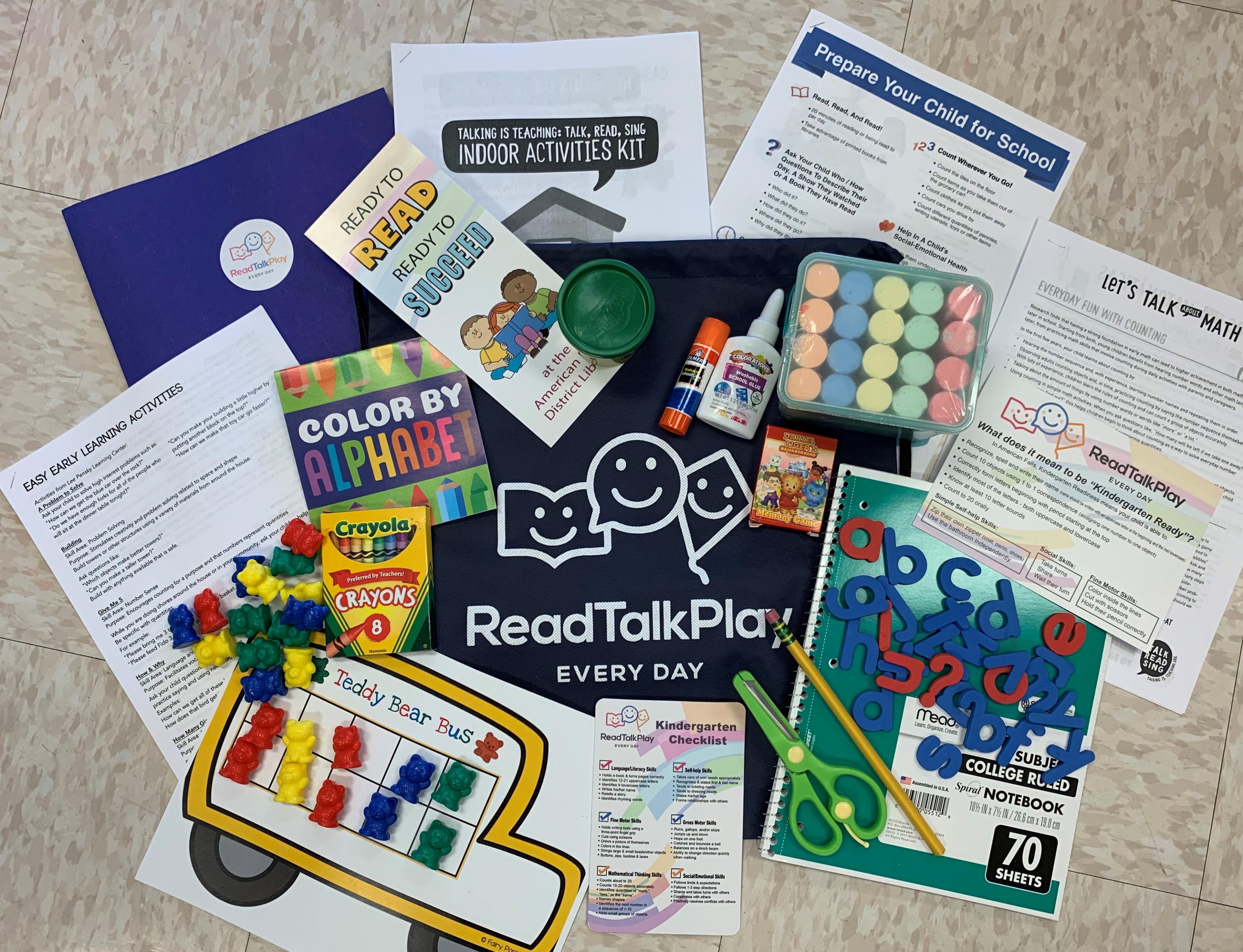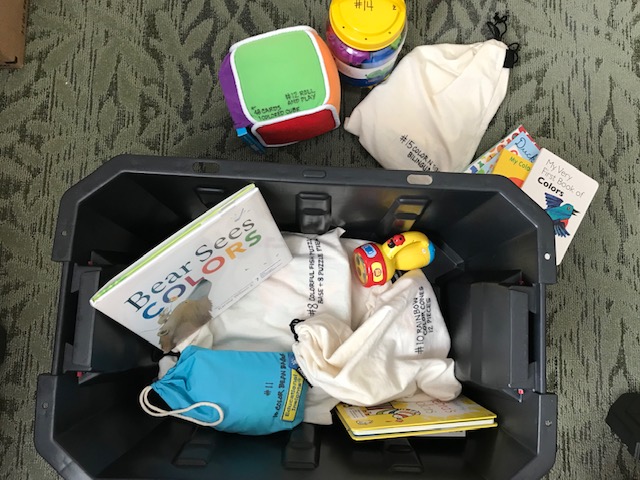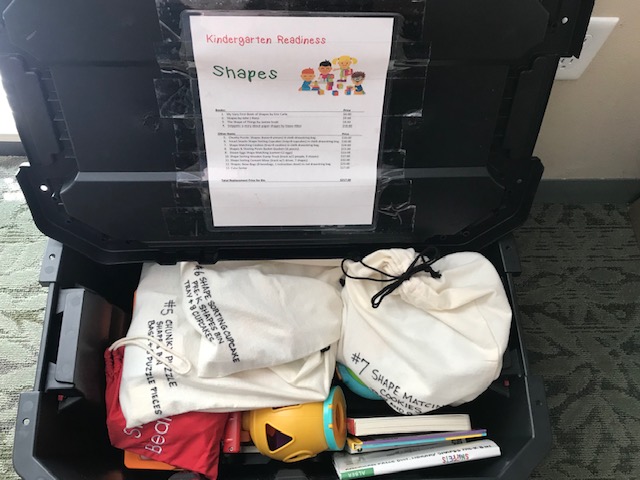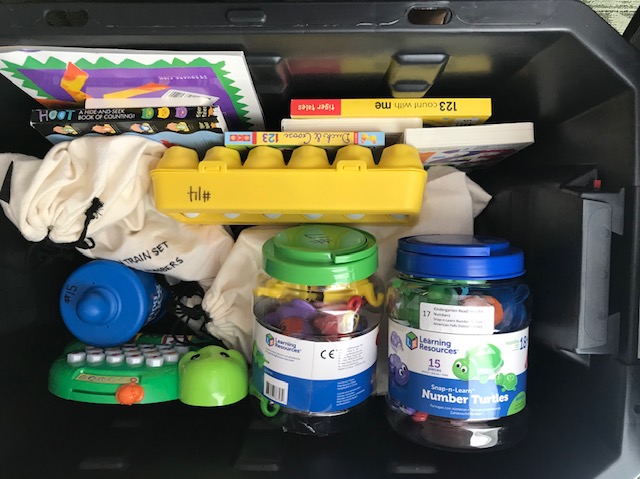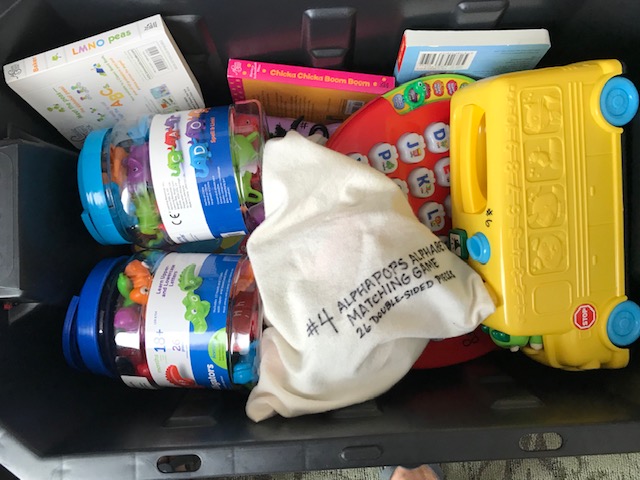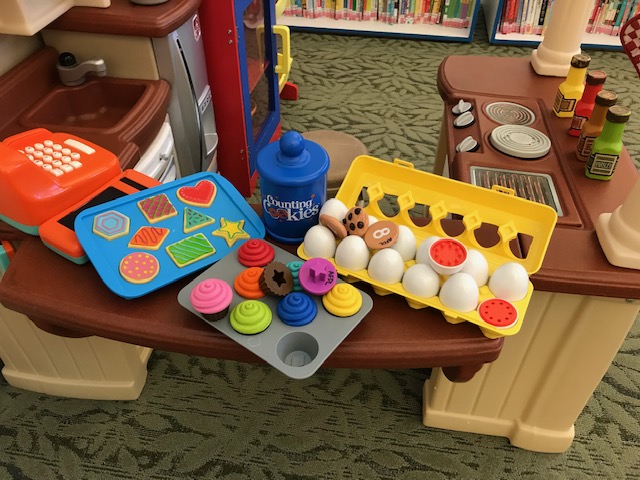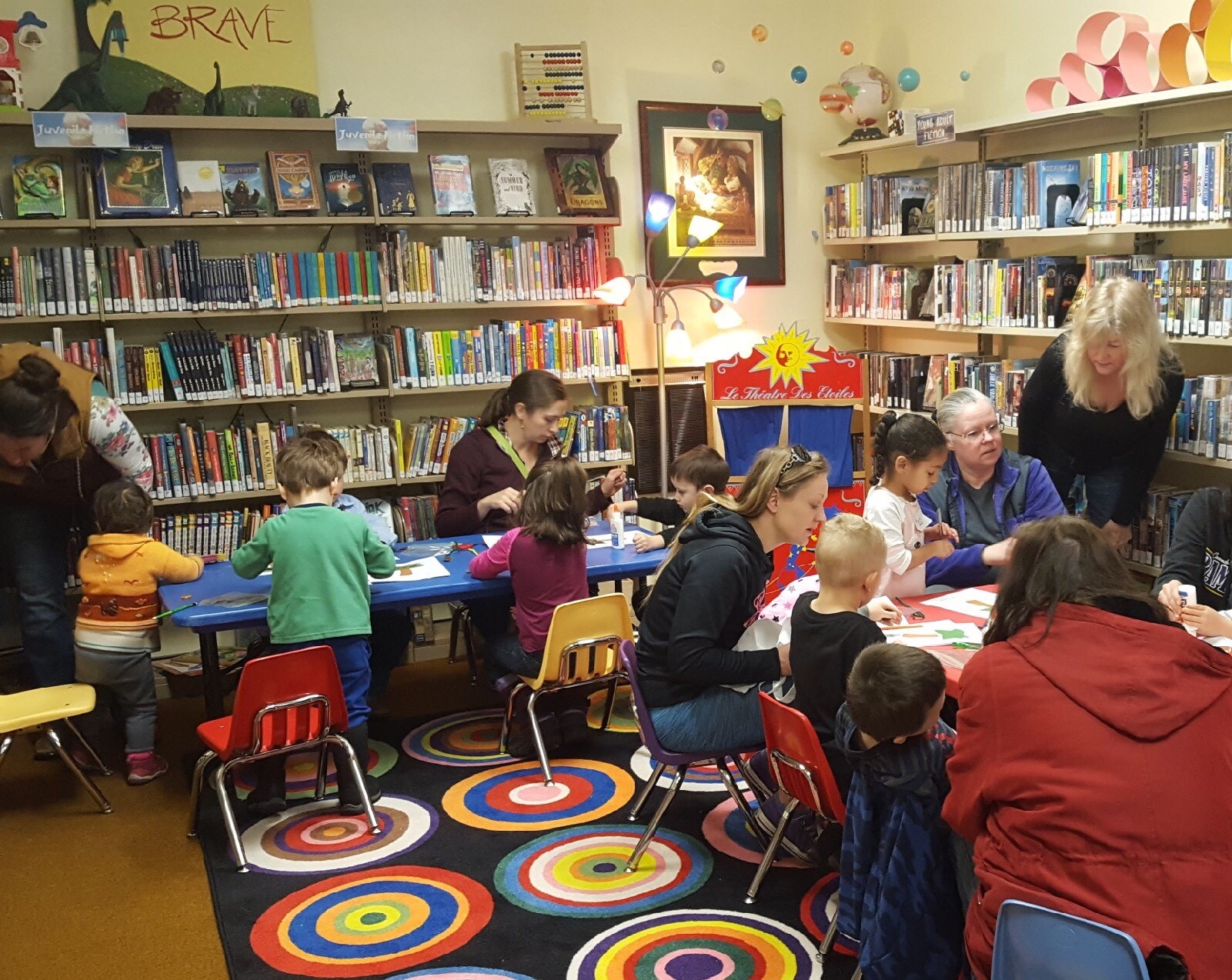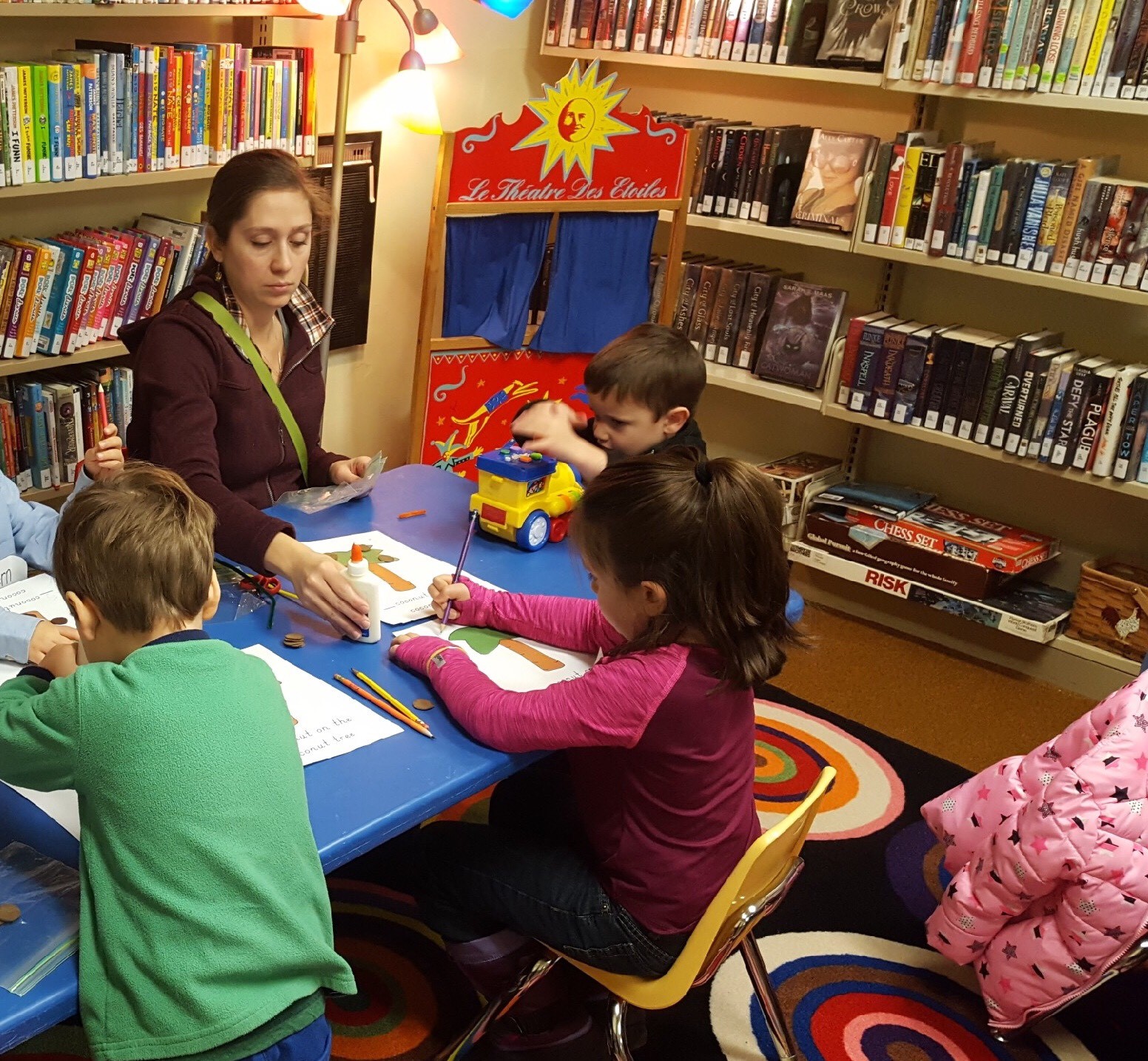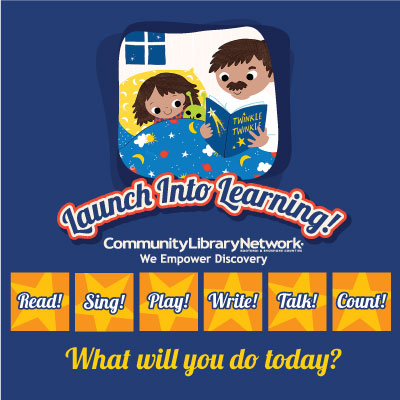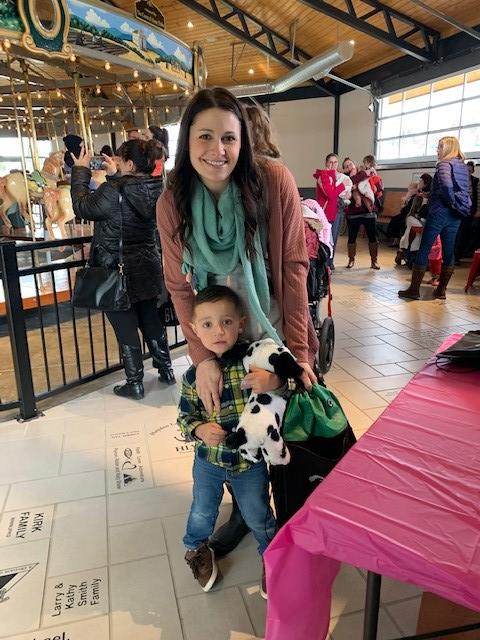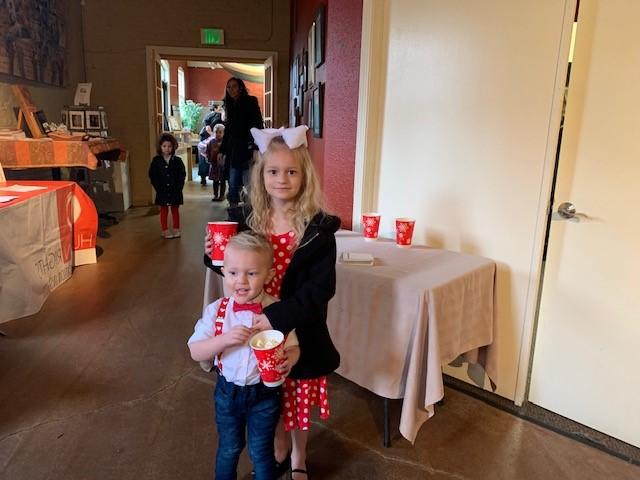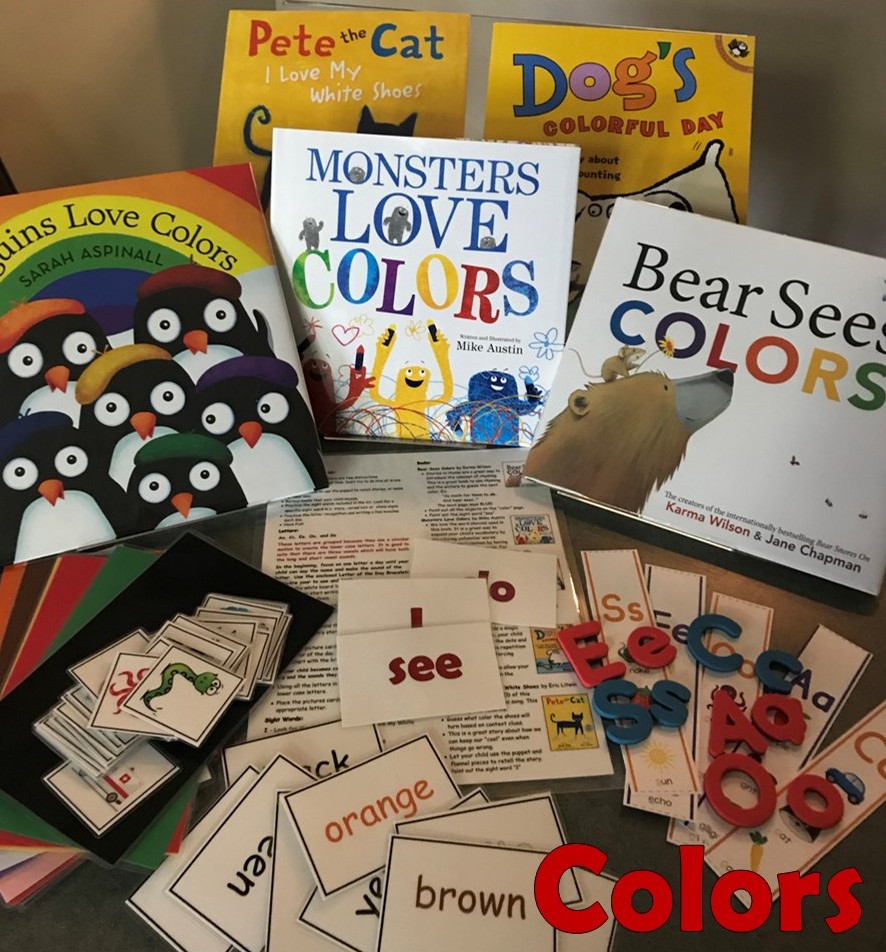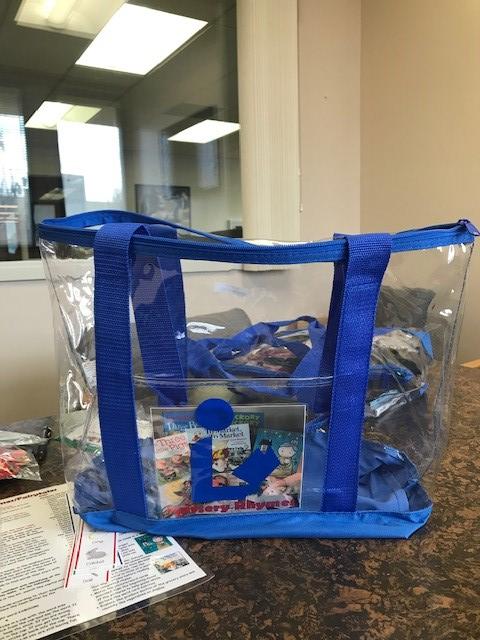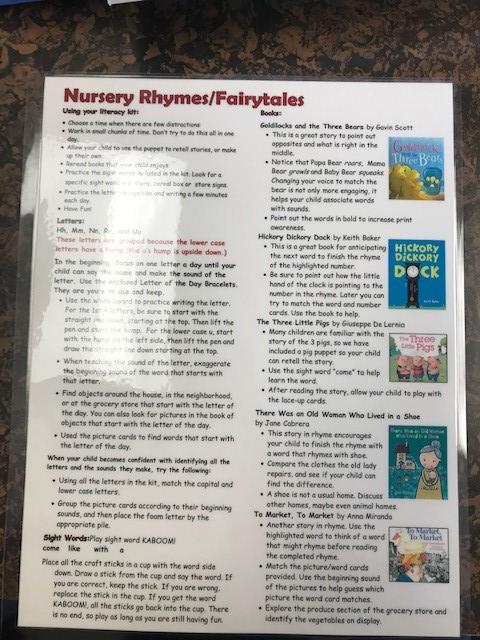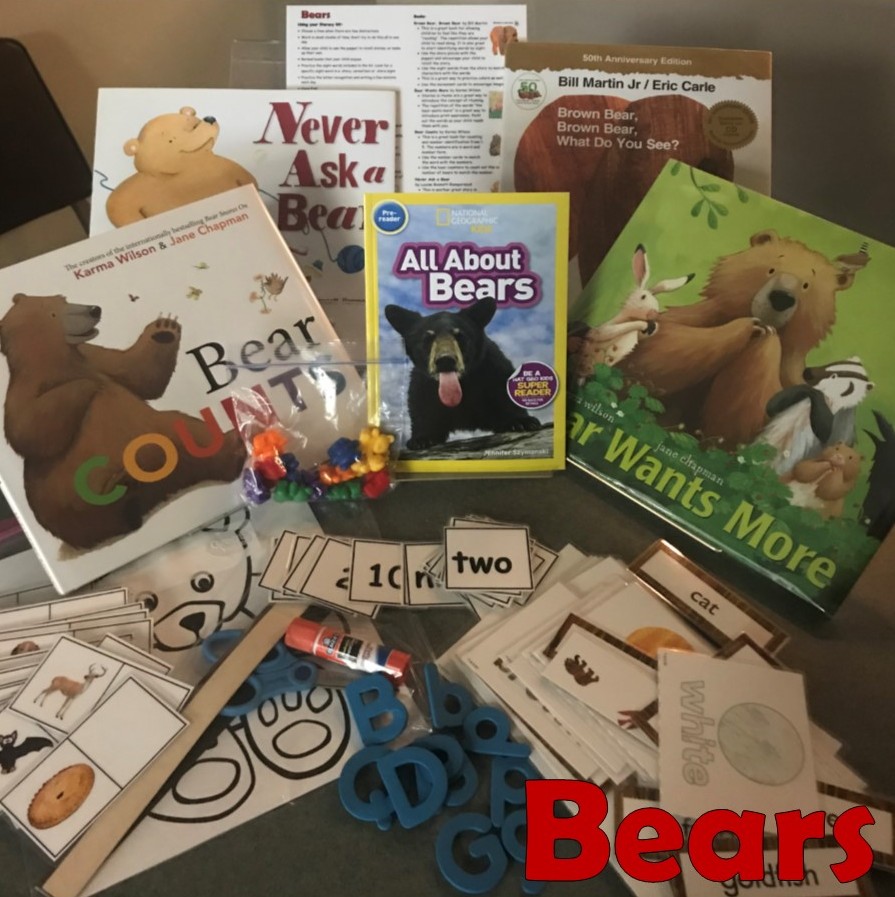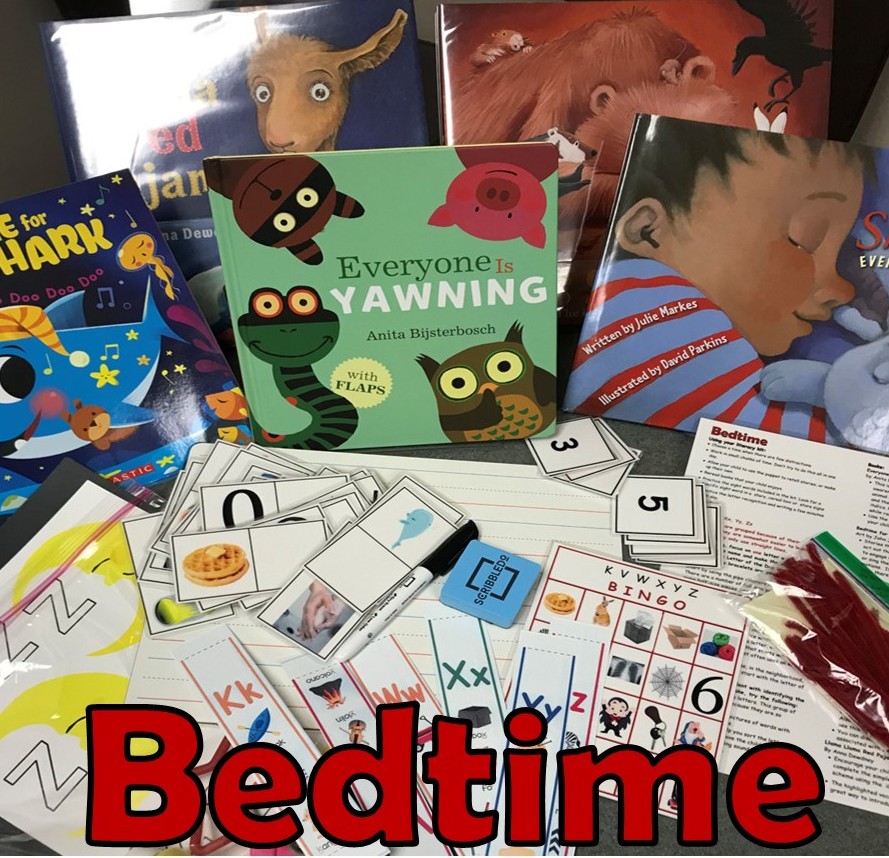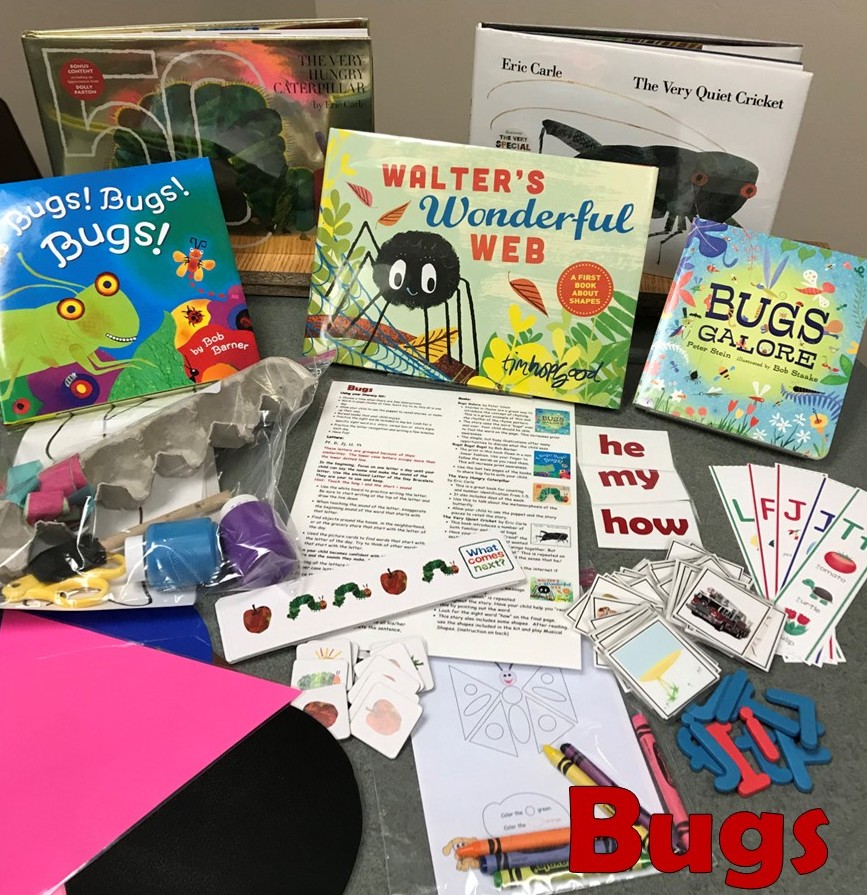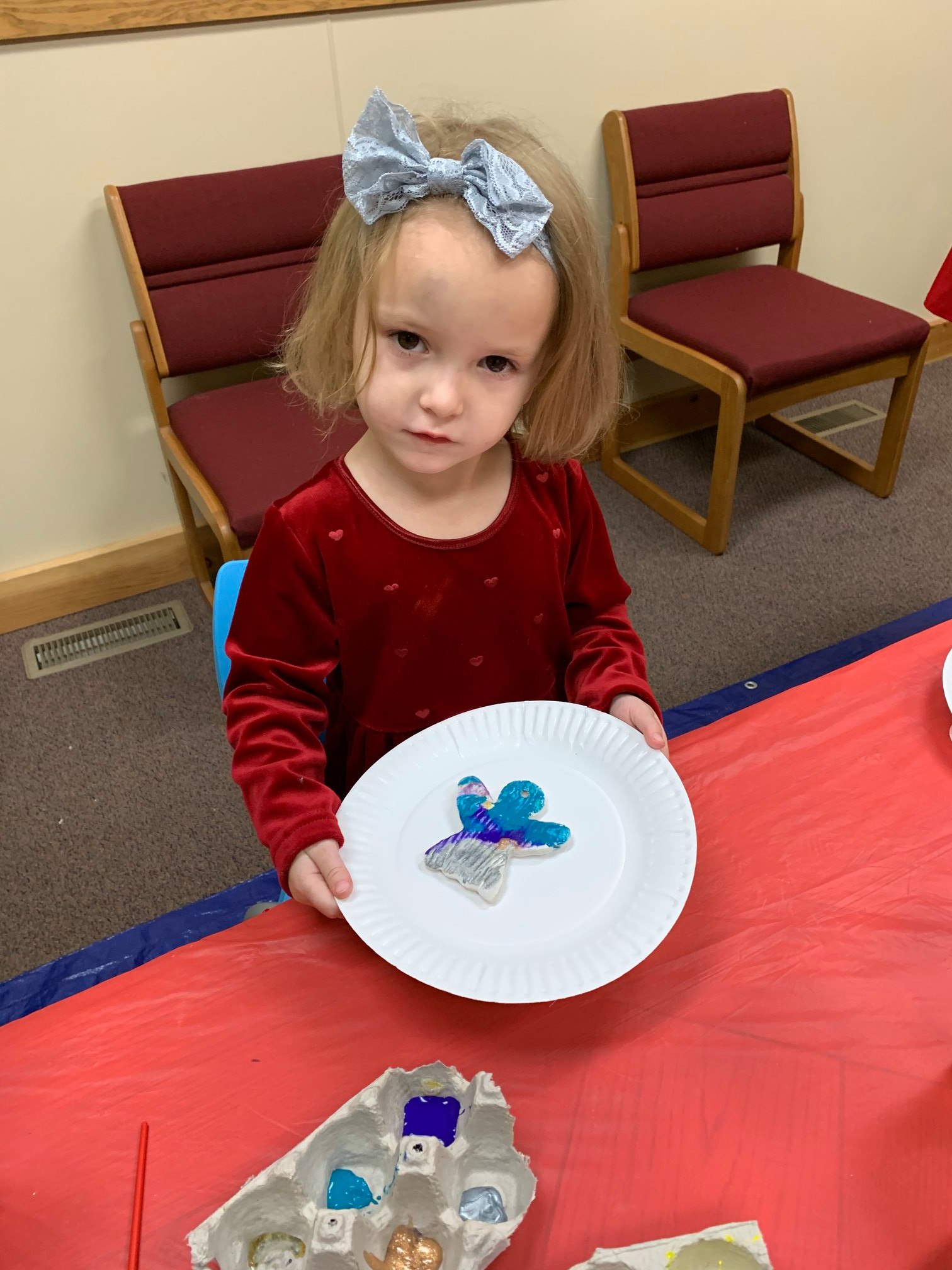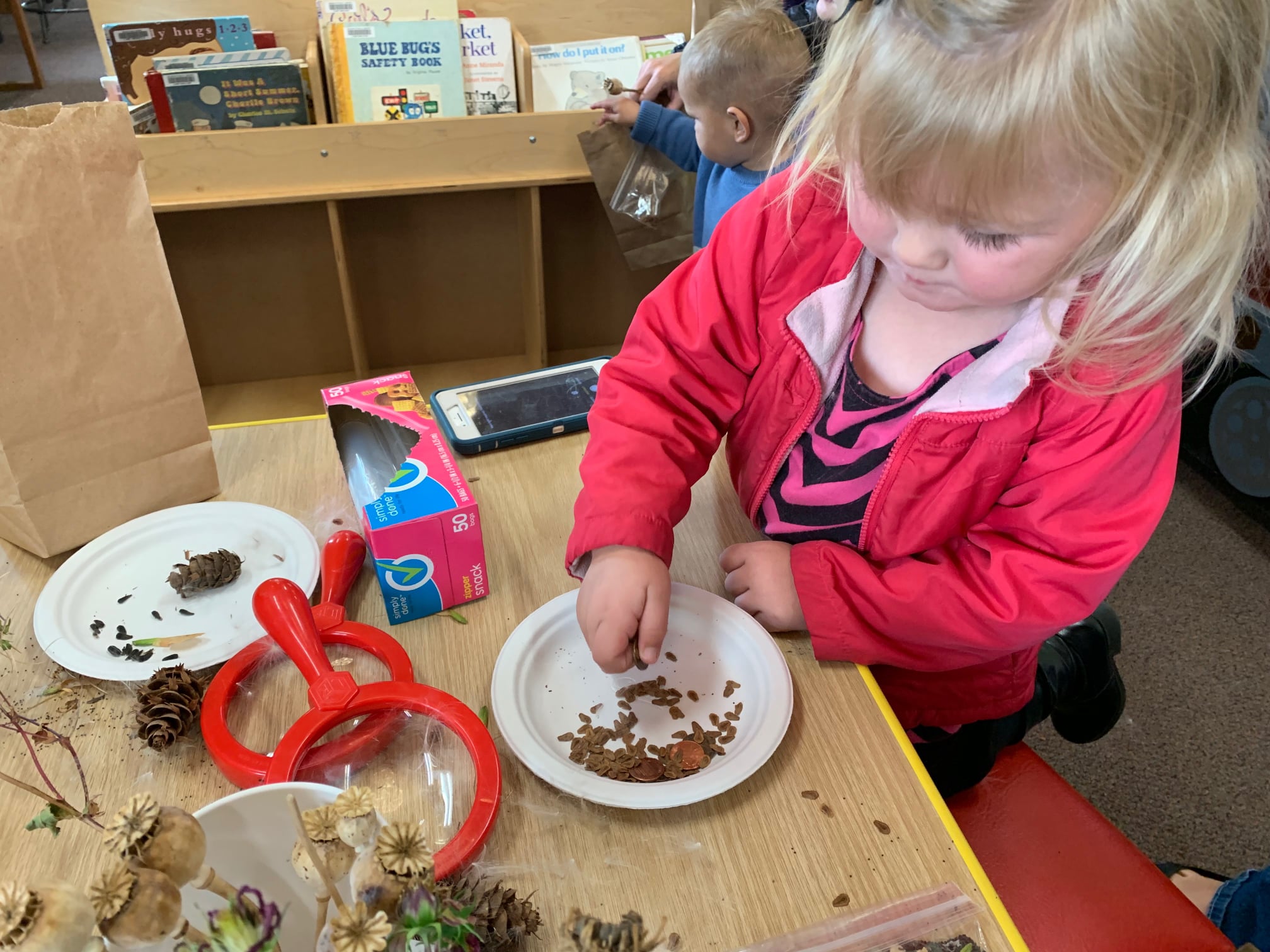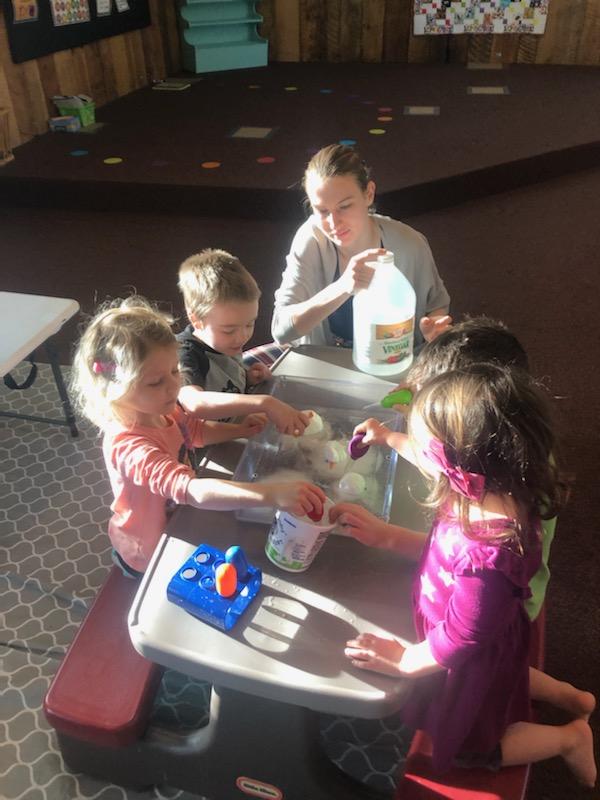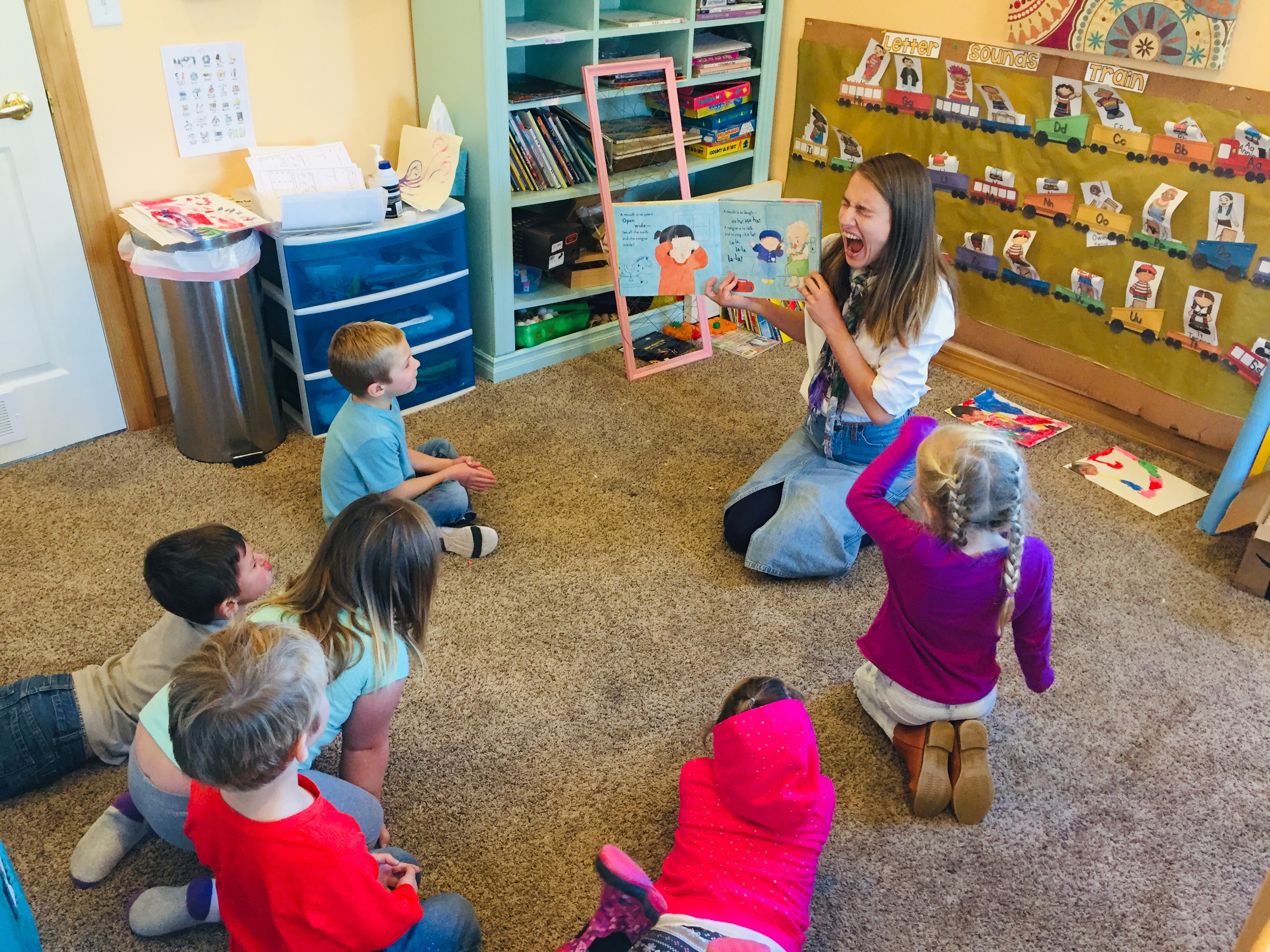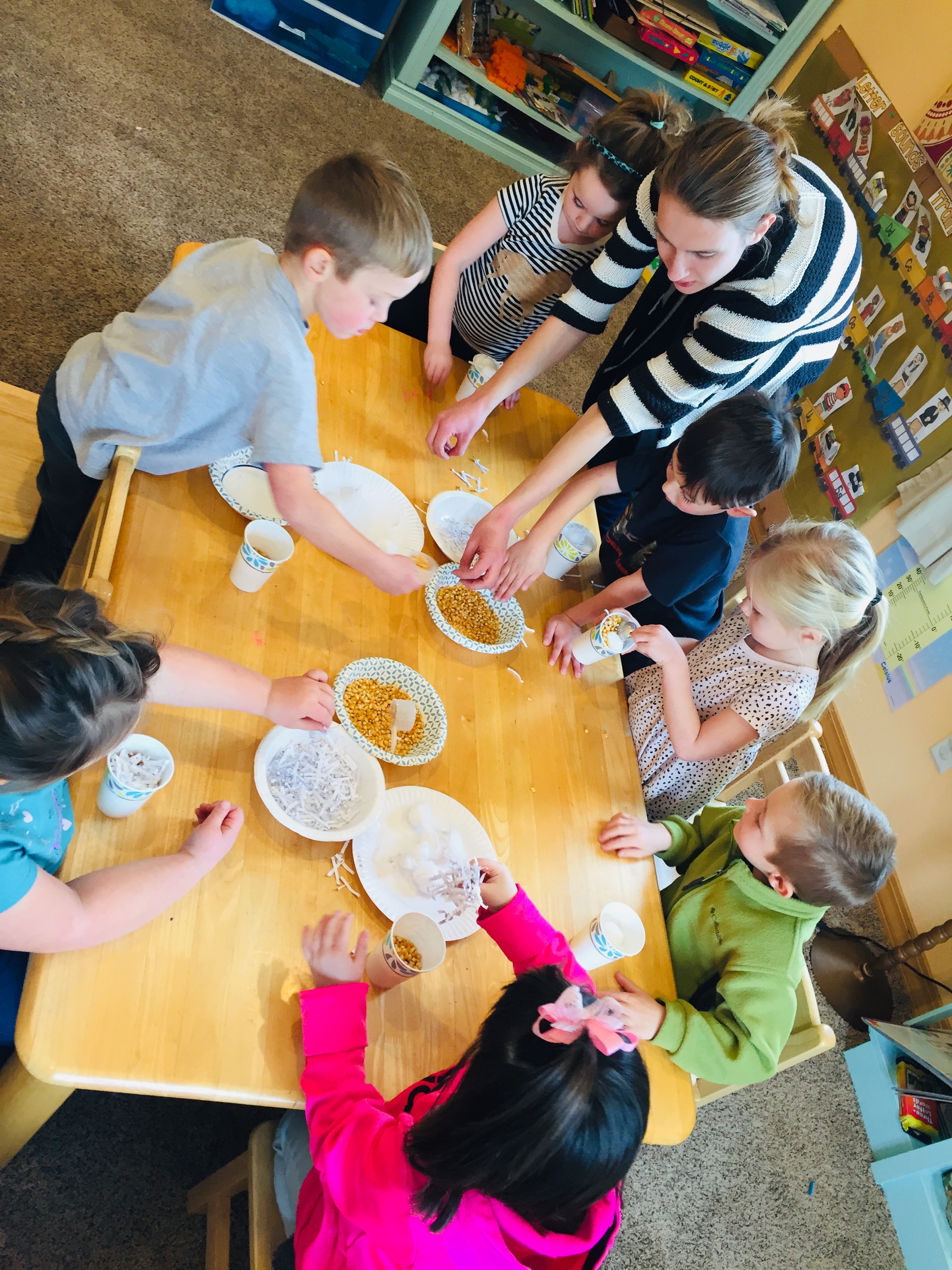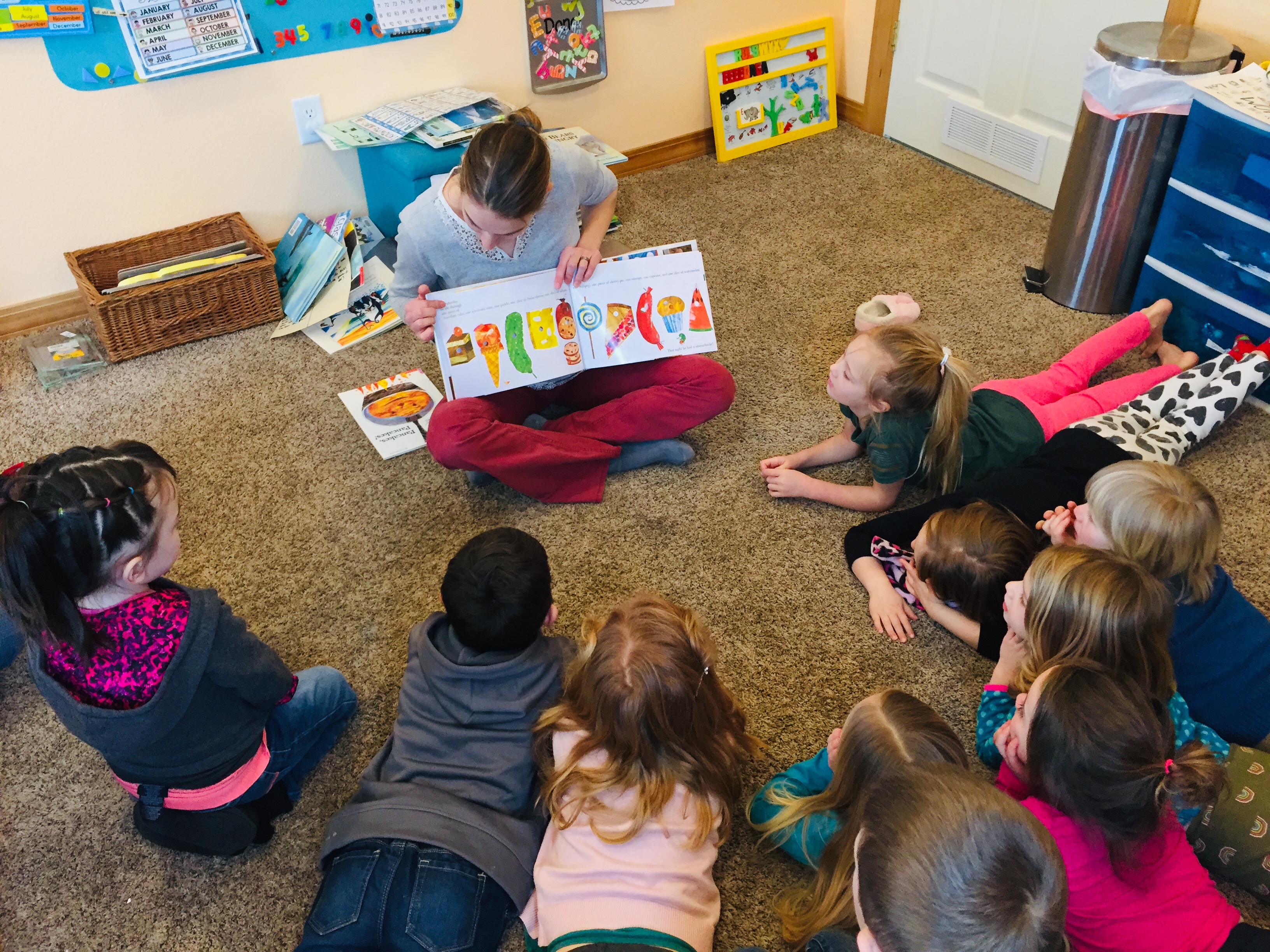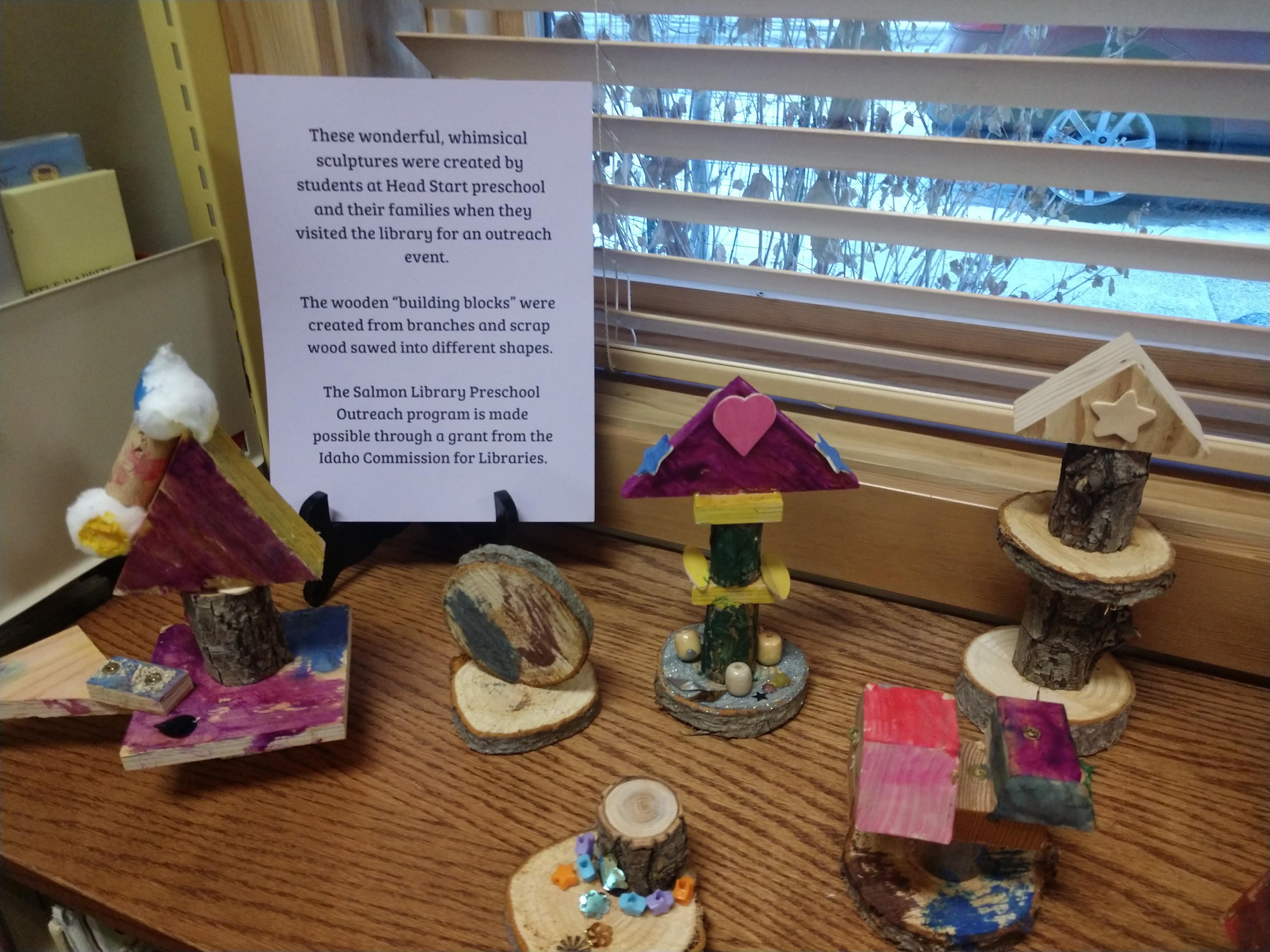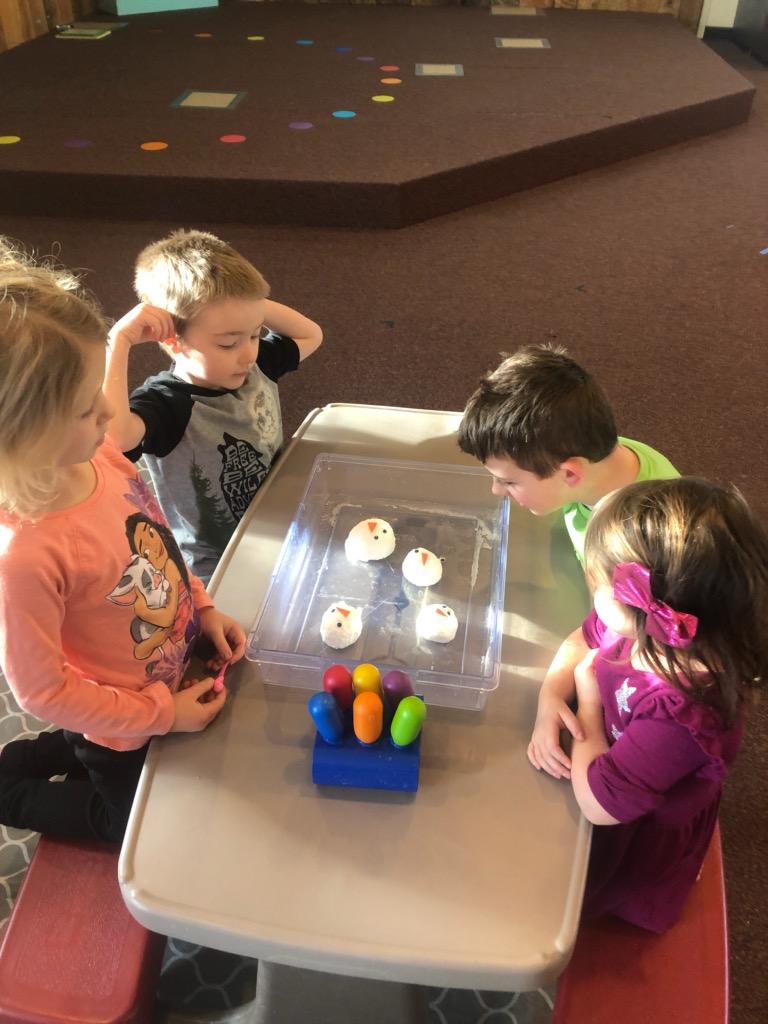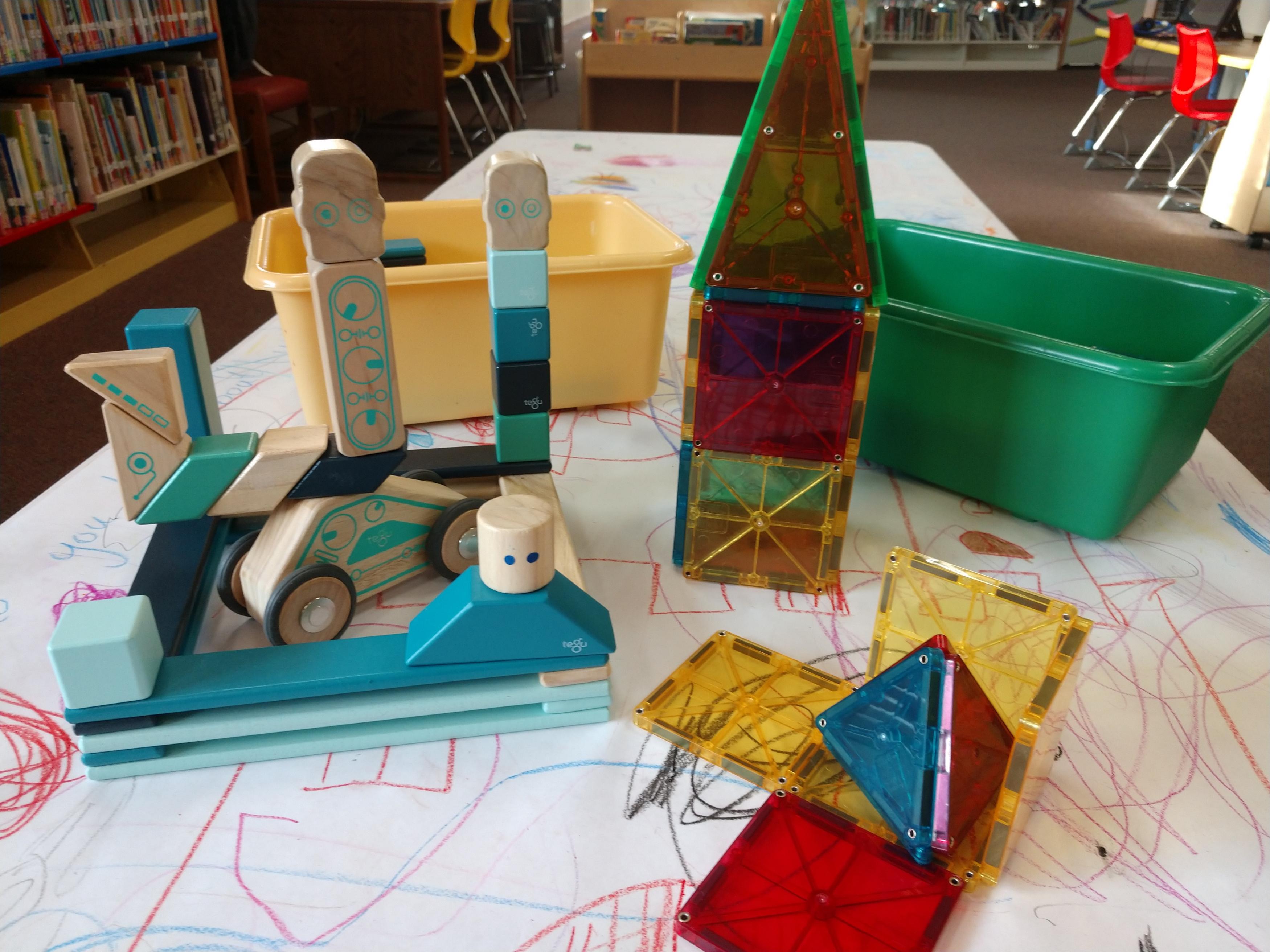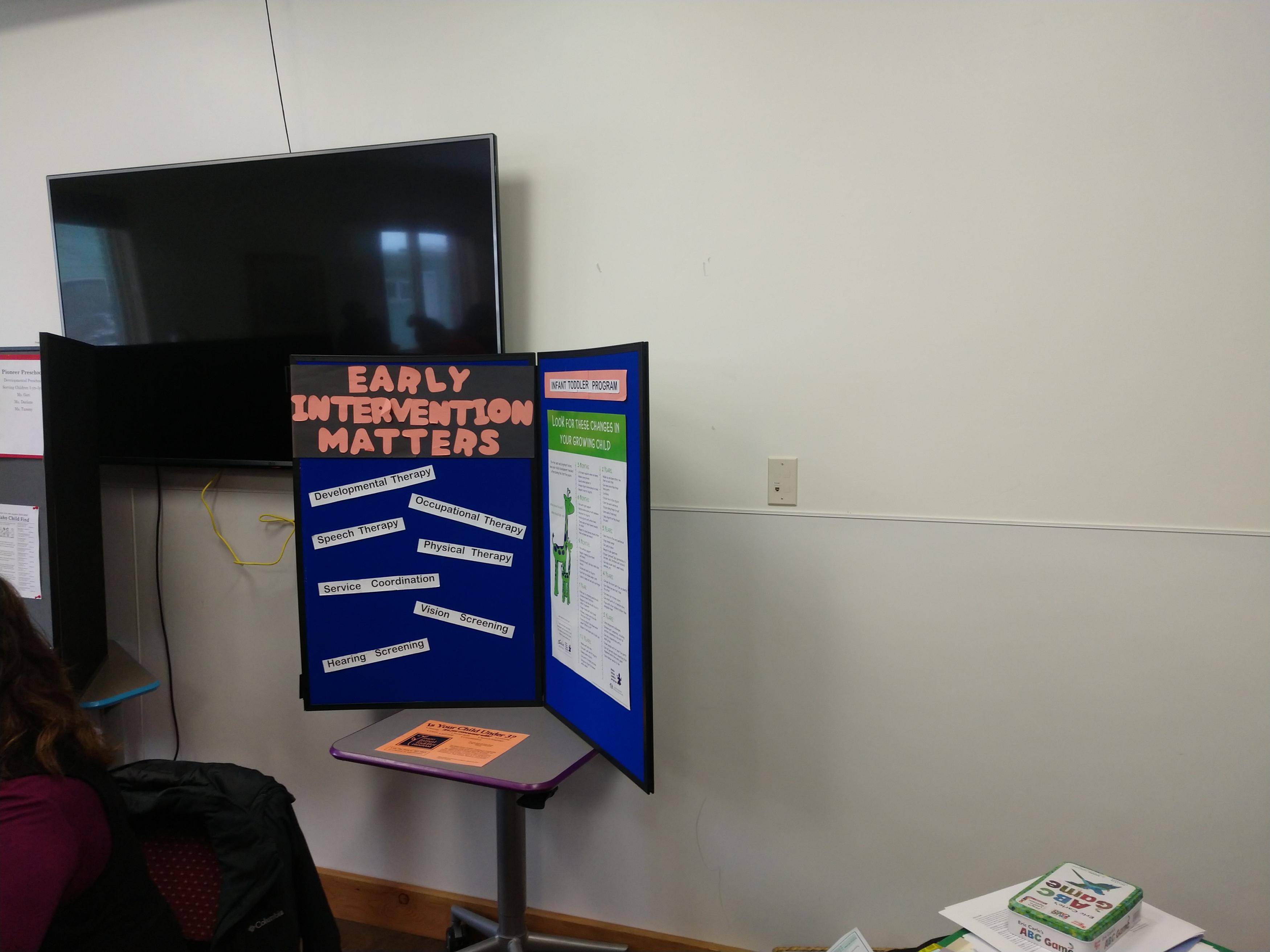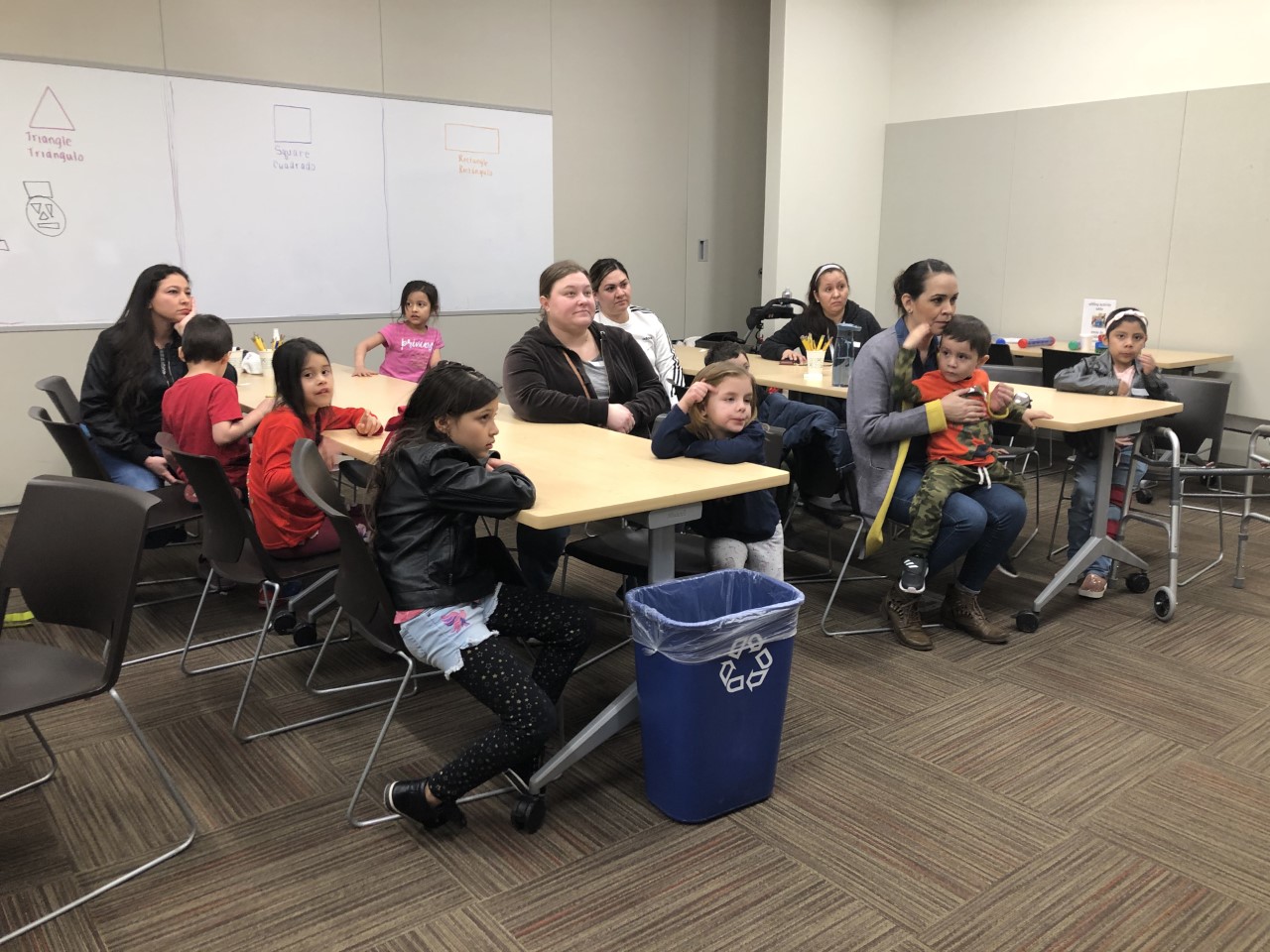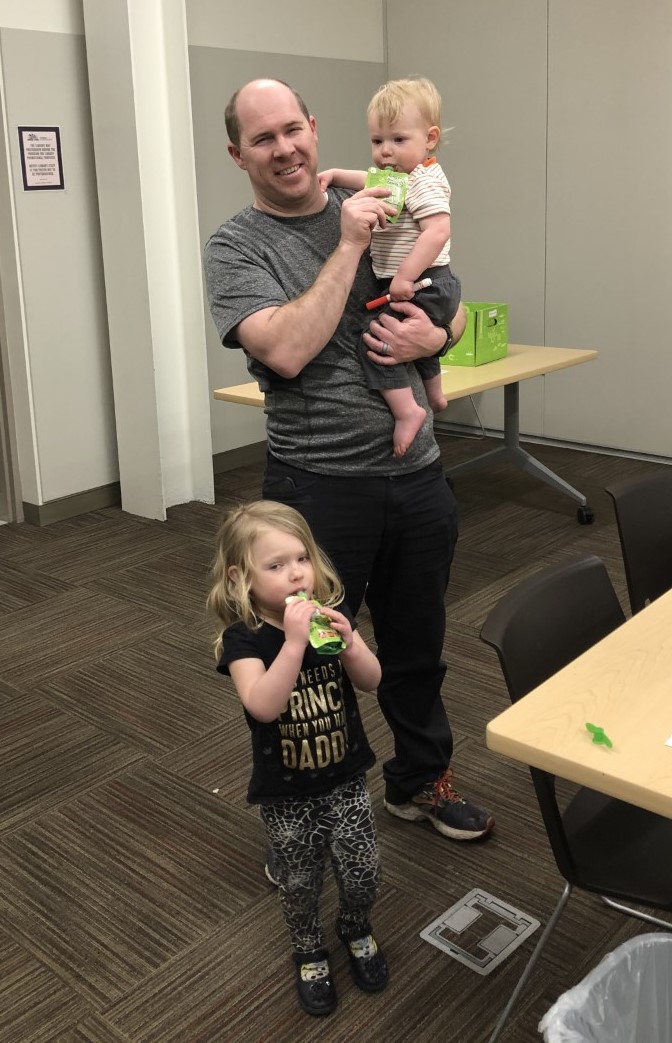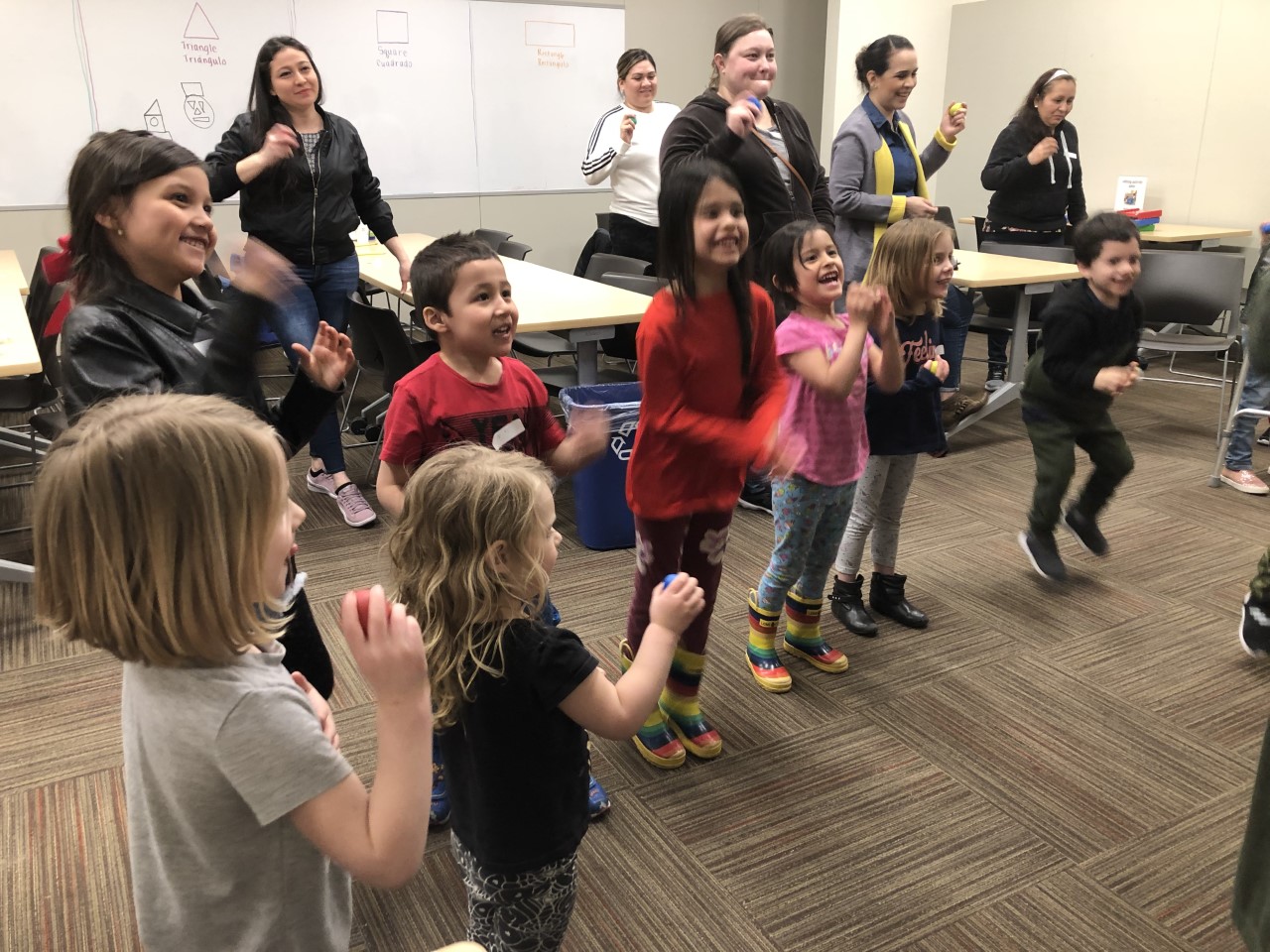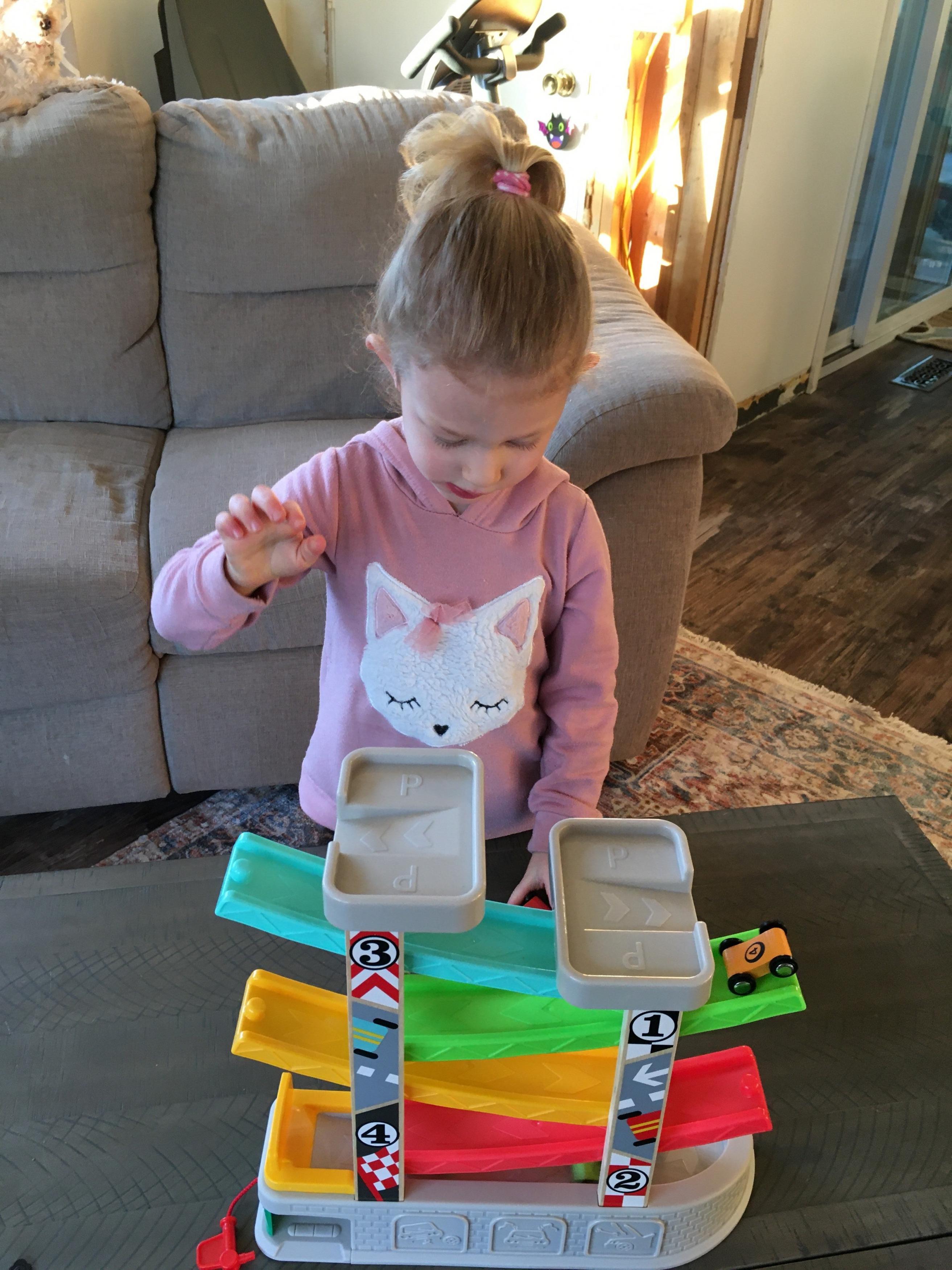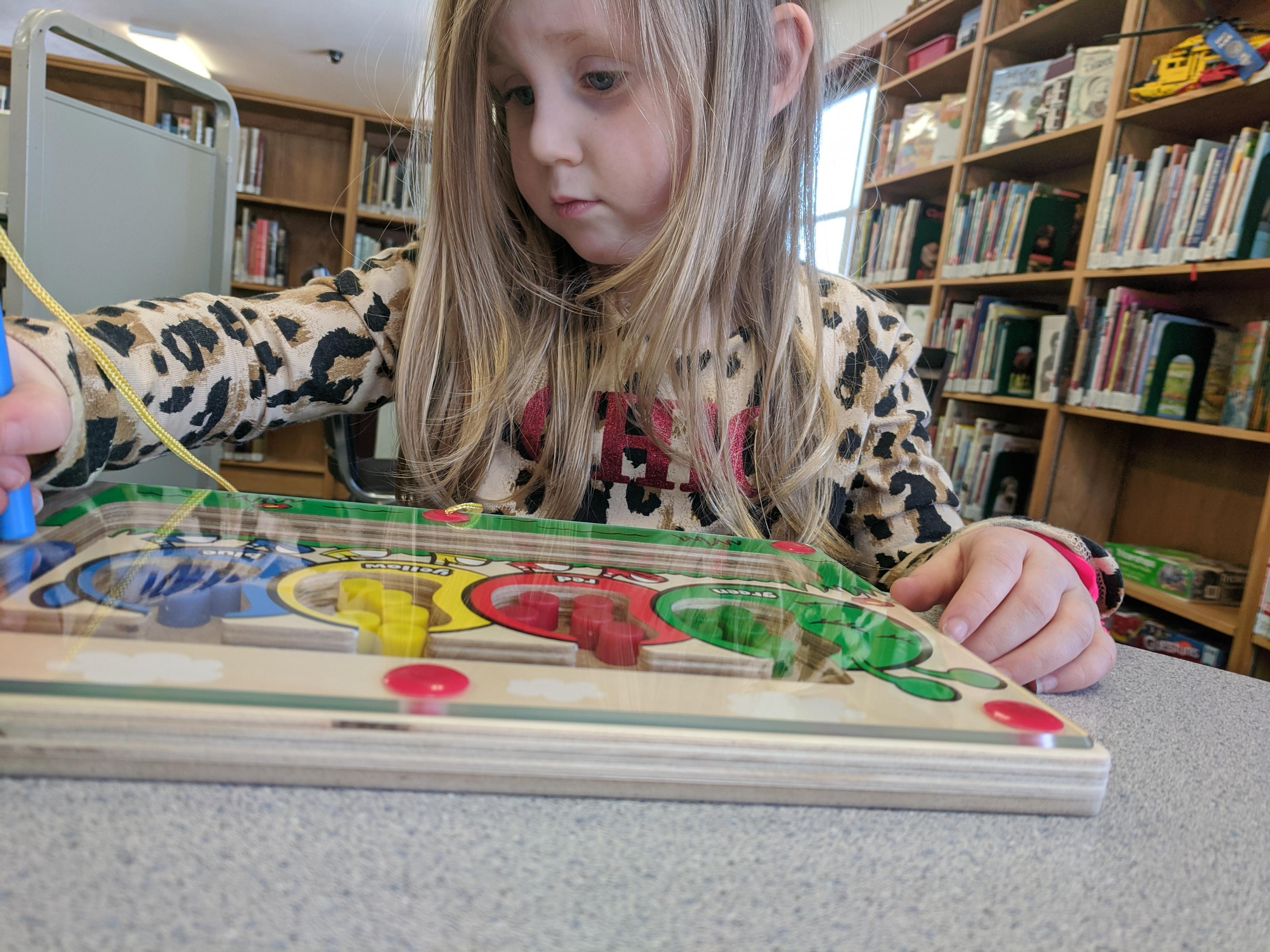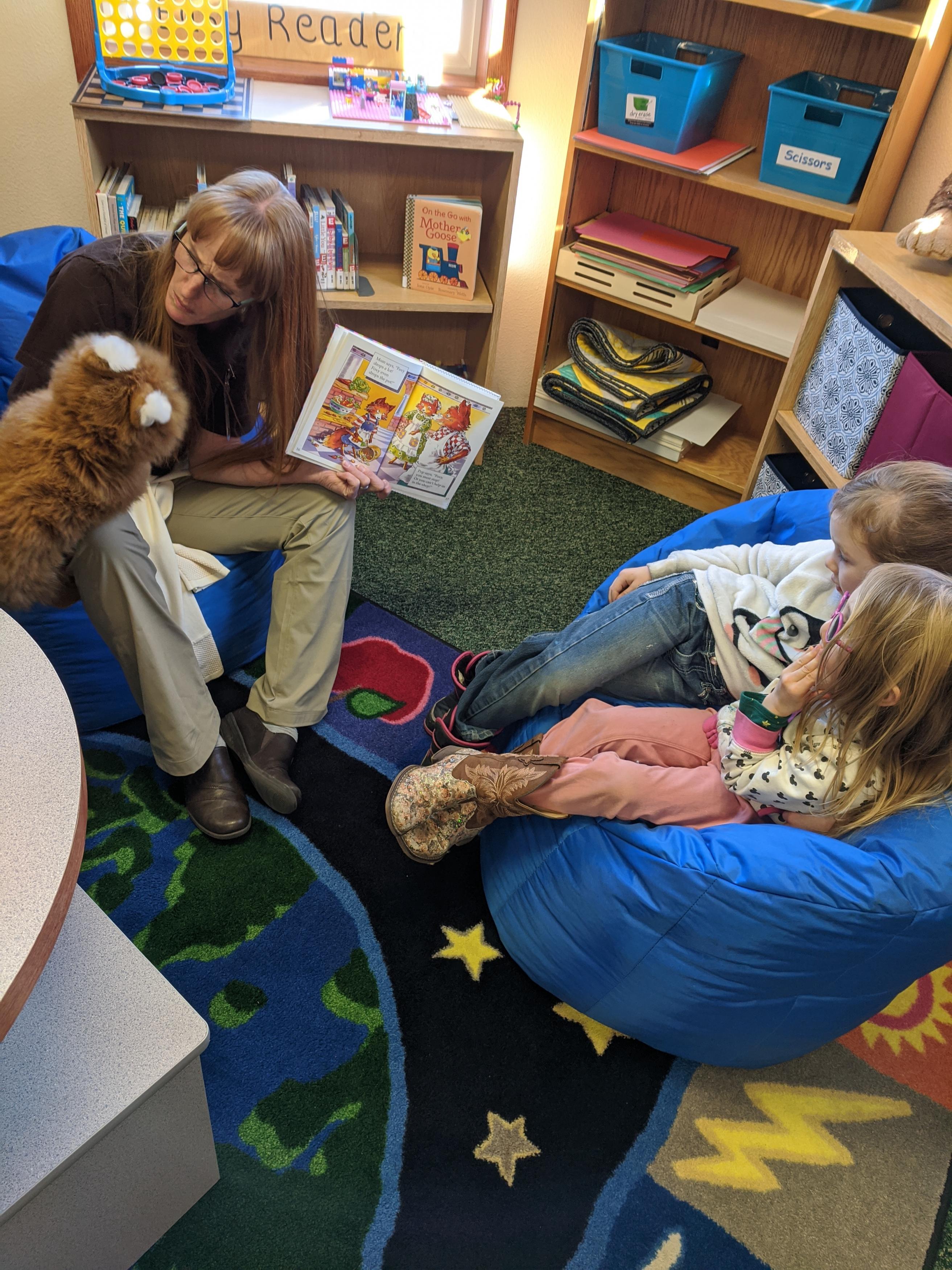American Falls District Library
American Falls, Idaho
Awarded: $10,000
Partners: American Falls School District/ ReadTalkPlay Committee, Idaho Public Television
Project:
The American Falls District Library used a multifaceted approach utilizing existing community organizations to support and promote early childhood education in American Falls. They worked collaboratively in the following areas: holding weekly story times in Spanish, partnering with Idaho Public Television (IDPTV) to hold family STEM nights, working with AF School District’s Read Talk Play Everyday initiative (RTP) to create and distribute kindergarten readiness publicity materials and summer learning backpacks, creating preschool skills kits/bins for patron and preschool use, and establishing stay and play activities in the library to promote readiness skills.
Best Practices:
- Holding family programming events in the evening: We found from holding our family STEM nights in the evening that families appreciated the additional programming hours. Many families who are not able to attend our weekly, daytime story times were able to attend our evening programming and voiced their appreciation for the events.
- Partnering with RTP: Through our partnership with AF School District’s RTP initiative committee we found strength in being part of a cohesive community plan to promote, and strengthen early learning in American Falls. By collaborating we were able to strengthen the success of our program by utilizing resources (publicity, communication, & support) cohesively that were mutually beneficial to the library and the school’s initiative.
- Community education materials & summer learning backpacks: Through our collaborative efforts with RTP, we were able to successfully create a list of kindergarten readiness standards that can be used and promoted throughout our community. We also used these standards to create summer learning backpacks to provide and help parents provide learning opportunities and resources to teach these standards at home.
Biggest Success:
Our biggest success was the collaboration that took place with our partners, IPTV and RTP, and how by working together we were able to promote Kindergarten Readiness in our community on many different levels and in different ways than we had previously been able to. Through collaboration, we were able to produce educational materials to highlight the skills necessary to be kindergarten ready. We were able to teach and promote those skills during our STEM nights, having many families who are not normally library frequenters attend, at our Spanish story time hour, and with new preschool skill kits/bins available for checkout and library use. Head Start was able to use the skill bins we created during parent meetings with students, to show parents how to play with and teach their children through play. We also collaboratively put together 150 summer learning skills kits that will help parents have resources and ideas of activities to do with their children over the summer to help them develop skills necessary for kindergarten. Through our collaboration we were able to reach a broad range of families and provide education, materials, and knowledge about kindergarten readiness.
Caveats:
- Planning and holding events during Parent Teacher Conference week when the elementary school was out, was not a great time to hold an event. We had the lowest turnout at our STEM night when it was on a date when school was out.
- Finding a good way to expand our Spanish story time hour. We tried communicating through the school district’s Hispanic parent group, migrant council, word of mouth, businesses, individual contacting and other avenues and were never able to gain traction in our program. In the future we would try to hold our program during a different time of day or in the evening.
- Having our final two STEM nights canceled because of COVID-19 was frustrating. We were able to utilize the books we purchased to create reading bags for Head Start students that were handed out to families during the Stay at Home order. We also were able to create summer learning backpacks to give to families to help with early learning education at home during the pandemic to help offset the cancellation of our STEM nights.
Biggest Challenge:
Besides COVID-19 halting the momentum of the programming of our events, the biggest challenge we faced was our Spanish Story time program. We tried so many different avenues to advertise and promote our program and were never able to get a consistent larger attendance. We have a decent number of Hispanic families that attend the library and utilize it’s resources, and would communicate to these families about the story time, and each family would seem excited to attend and express interest in attending. But, many never attended. We were able to learn that communicating what library programs are in better detail (for example explicitly saying registration not required) is important when promoting and translating the promotion of the program.
Evaluation:
Surveys at STEM night workshops: Surveys conducted at the beginning and end of each STEM night (see Documents and Resources). Parents had to turn in a completed survey before their children could receive the provided books and other promotional education materials from RTP. Many parents surveyed reported that they didn’t have a good understanding of STEM and were not comfortable doing STEM activities with their children, or using STEM language before our STEM nights. The majority of parents reported that they felt more comfortable doing STEM activities, using STEM language and had a greater understanding of STEM after each of our STEM nights.
Surveys periodically at our Spanish Story Time Hour
DOCUMENTS AND RESOURCES
STEM Night Flyer-English Spanish
STEM Night Survey-English Spanish
CONTACT INFO
Kindra Munk
Director
PROJECT GALLERY PICS
Cascade Public Library
Awarded: $5,000
Partners: Cascade School District, Horizons Lifestyle and Education Team
Project:
Working closely with Cascade School District to develop an adjunct Kindergarten Readiness program consisting of outreach and in-house programs and materials, targeting children who do not qualify for the school’s developmental preschool program. Components include: Enhanced storytimes; bimonthly kindergarten readiness programming; K Ready kits for checkout (educational materials, mobile hotspot, tablet); outreach to families with non-traditional work hours; waiver of fees for out-of-district families living within school district. Also working with Horizons to build on existing after-school program to include additional K Ready programming.
Our project ended up looking a lot different than we originally planned, due to the library being closed during the COVID-19 crisis. Rather than conducting five in-person program sessions between February and May 2020, to be attended by both parents/caregivers and children, we were only able to hold two sessions. The tablets, backpacks, and supplemental handouts ended up working well, and we provided a kindergarten readiness backpack to each family to keep.
Best Practices:
- Tablets – Providing electronic tablets pre-loaded with games and activities specifically targeted for pre-schoolers aged 3-5. Of the five different apps that we loaded, we got the best feedback about Khan Academy Kids, and PBS Kids. Our tablets were locked and managed through a Google Family account to ensure kids could not accidentally download any aps or make any purchases. This allowed parents/caregivers to feel comfortable letting their kids play with the tablets without worry or concern.
- Skill-building Backpacks – We purchased a number of activity backpacks for the library’s collection, as well as incentive backpacks that each child got to keep at the end of the program. We got good feedback from families that children enjoyed and engaged with these backpacks at home. We made sure to have different backpacks in our collection so K-Ready families could swap them out as needed for variety.
- In-person engagement – Our families really appreciated being able to meet in person, and for their children to engage in fun interactive activities with other kids from the community. Living in a far-flung rural community, families are often isolated and don’t have many opportunities outside of school for their children to engage in group learning. We were only able to offer two in-person sessions prior to closing down for COVID, but both were very successful.
Biggest Success:
We had been a little worried about whether we’d be able to recruit enough families for the program. However, we were pleasantly surprised by the interest and turnout. We set our program capacity to 10 children, as this many children with parents is the maximum we can fit in our kid’s area for the in-person sessions we had planned. The popularity of both Story Time and K-Ready demonstrated just how much of a need there was in our community for these types of programs. Our K-Ready families said that even when stuck at home, kids were very engaged with the activity packets we sent out, and were eager for ways to continue with their learning.
Caveats:
We were not able to fully implement the program in the way we had planned due to COVID closures. We were only able to offer two of the five in-person sessions we had planned, and both of these were largely successful. For the other three sessions, we mailed out packets of handouts and activities and connected with families by email to see how they were doing. It’s hard to say how we might have improved our program without having the opportunity to truly implement it the way we intended. If we had seen the global pandemic coming, we might have loaded Zoom onto the K-Ready tablets so we could meet virtually with our families.
Biggest Challenge:
COVID-19. However, in spite of this global crisis, we were able to continue the program remotely via email and mailed activity packets. Several families expressed gratitude for having the tablets at home during isolation, as they were a useful tool for keeping their kids engaged. Families also provided positive feedback about the three different packets of handouts and activities we mailed to them in lieu of our in-person meetings.
Evaluation:
Our plan was to have parents fill out a very short questionnaire on the first day of the program and then fill out the same questionnaire on the last day of the program. We collected the pre-survey but were not able to distribute post-surveys since we only offered two sessions.
DOCUMENTS AND RESOURCES
CONTACT INFO
Barb Sherman
Program Coordinator
PROJECT GALLERY PICS
Community Library Network
Hayden Branch
Awarded: $10,000
Partners: United Way of North Idaho, Post Falls School District, Opening Books Opening Doors, Coeur d’Alene School District, Mountain States Early Head Start
Project:
Launch Into Learning is a collaborative Kindergarten Readiness project designed to provide tools and resources to families throughout our community. Building upon our strong community partnerships, we developed a committee to create the Launch Into Learning backpacks and Activity Guide. Coordinating with the school districts in our service area, we provided a backpack for every child entering Kindergarten, which would be distributed at Kindergarten registration day. post cards in each backpack invited families to the library for their free library card and a free book.
Library staff have been identifying alternate locations for backpack distribution, including our Pop-up Library events with the Discovery Bus, the Family Learning Corner at the SilverLake Mall, neighborhood drop-offs and school meal locations.
Best Practices:
- Identify key partners, 2-3, that will actively participate and understand their role in the project. While this project would need many partners for distribution, the initial planning committee was small and focused. Each member had a specific task and short-term commitment: United Way edited and printed the activity guide; OBOD provided “This Book” resources and feedback on key pieces of the project; the school districts coordinated with individual buildings to distribute backpacks.
- Partnering with the schools to distribute the backpacks. Understanding that the schools are a primary point of contact, and wanting to eliminate barriers to service, we partnered with the area school districts to distribute Launch into Learning backpacks at kindergarten registration. We provided 1450 backpacks to local school districts before the state shutdown. After that we shifted our plan to distribute to children when they register for summer reading. Using Beanstack, we created an electronic badge where parents enter their child’s name and birthday and receive an email providing them directions to pick-up a backpack at their local library. Pre-pandemic, principals expressed their interest and excitement about offering this program to incoming Kindergarten students. The activity book was an important selling point, as it provided families easy, hands-on STEAM and literacy activities they could work on all summer to prepare for school in the fall.
- Creating a family-focused activity guide that utilized materials families had in their home. Often times activity guides have projects that require items many families do not have in the home, or projects that are complex, which leads to frustration for kids and adults. Our goal was to create a guide that was rooted in early learning and Kindergarten readiness, so every child and family found success.
- Use the resources that are available to you and do not re-invent the wheel. We used the art from the Collaborative Summer Library Program. The high quality, engaging art was a perfect fit for our project. We used the evaluation tools from the Boise Public Library and East Bonner County Library as the basis for our project evaluation. United Way had the activity guide from a previous project and was able to modify it for this project.
Biggest Success:
Strengthening partnerships. This grant provided the backbone for enhanced community partnerships. Each partner was able to participate and have a specific task to ensure the success of this project.
- United Way was responsible for the Activity guide, from editing to printing, they took on this piece of the project which is the backbone of the project.
- Opening Books, Opening Doors provided “This Book” materials for each backpack. Age appropriate bookmarks and reading lists provided families additional suggestions and tied the Launch Into Learning project to the greater community literacy efforts.
- Coeur d’Alene, Lakeland, and Post Falls School Districts committed to distribute backpacks at Kindergarten registration. Backpacks were also available at all of our libraries.
- SilverLake Mall reached out to us about creating an early learning space that would be free and open to the community. The storefront at center court will provide the community a free space to engage with their children, focusing on the read, play, sing, talk, read skills children need to successfully start Kindergarten. The space will be used to host family literacy workshops, story times, and play groups. Community partners, such as Mountain States Early Head Start, can use the space for programming or family gatherings.
Caveats:
- Timeline. Be sure to factor in extra time for the unexpected. Library staff and community partners wear many hats and have multiple projects going at the same time. Be sure to allow extra time so those involved with the project do not feel rushed and it shows your value their time and contribution.
- Have a Plan B. No one could have known that a pandemic would sideline all of our work, but looking back it would have been smart to have alternate plans. This has been a good lesson for us and the “What if…” worst case scenario model.
Biggest Challenge:
COVID-19. We kicked-off Launch into Learning two weeks prior to closing our doors due to the pandemic. During the closure we needed to re-invent the project and mechanism to reach families. Our data is incomplete as we have not been open and the schools have had to modify their registration process. Schools are still working on plans to distribute the backpacks, which may not occur until this summer.
During this project we also had major staffing changes, which set our timeline back. Building in extra time to our timeline to account for bumps in the road would have helped us navigate the changes.
Evaluation:
We included a post card in each backpack that invited every family back to the library to get a library card and receive a free book. When families signed up for a library card they were entered into the drawing for a backpack with all the supplies their child would need when they entered Kindergarten in the fall.
We created an online parent survey, modeled after Boise Public and EBCL. This information will be used to help us enhance this project and identify gaps in service. At the end of the survey they could enter their email address to be entered into the drawing.
Some key findings:
- The community is looking for ways to not only support, but raise awareness about the importance and need for early learning.
- Principals were eager to distribute backpacks to support Kindergarten readiness.
- Families were appreciative of the materials to prepare their child for Kindergarten, as many are unaware and overwhelmed with how to get their child ready.
DOCUMENTS AND RESOURCES
Launch Into Reading Activity Booklet
Website: www.communitylibrary.net/drupal7/content/launch-learning
CONTACT INFO
Karen Yother
Youth Services Coordinator
PROJECT GALLERY PICS
Jerome Public Library
Awarded: $7,500
Partners: United Way of South Central Idaho, Northside Head Start, First Baptist Preschool
Project:
Targeting low-income and Spanish-speaking families, the following components helped educate parents and help them prepare their children for kindergarten: Ready! for Kindergarten workshops in English and Spanish; Spanish storytimes (both at the library and through outreach); early literacy kits for checkout, English and Spanish; library card outreach to Spanish-speaking families, low-income families, and out-of-district families whose fees were waived by sponsorships; vision and hearing screenings during storytimes. The library worked with community partners to identify and reach target families.
Best Practices:
- Ultimately what ended up being most effective was the Spanish storytime and Spanish READY! classes. Several of those parents got cards. However, others were still afraid to checkout books for fear that they would damage them. We even offered to pay for any damaged books through the grant, but couldn’t break that barrier.
- The literacy kits were a huge hit. Although it was difficult to get surveys returned, most of the people who checked out kits, checked out multiple kits. Return customers was a measure of success for us. We created one kit and met with kindergarten and first grade teachers to get input. They were able to tell us the things they would like to see in students who would be attending their classes. A couple of the things they mentioned was to have children be able to write their own names, have sight word recognition, and scissor skills. Those things were added to our kit.
- The READY! classes were also successful. Having 18 Spanish-speaking families impacted through the READY! program was great. Creating a connection with those families and having them attend Spanish story time and/or check out library books was an added bonus. Most of the people in the READY! class were new to the library. We know that getting people in the library building itself is the first hurdle for many of our Latino families. Being able to offer the program for free was a huge draw. We did not have as much success drawing in low income English-speaking families. Yet…
- I still believe that attending parent nights at preschools, daycares, Head Starts, and doing pop up story times is the way to reach families who are not already library patrons. Covid-19 really put a strain on those plans. I think we will continue to do this once we are able to, but we plan to have more of a performance at these events so that we can draw and hold the attention of the children, while other staff talk to parents.
Biggest Success:
During the grant cycle, I think we were most successful in reaching our Latino community. Weekly Spanish story times both in the library and offsite at a day care outside our service area, enabled us to impact children who did not frequent our library previously.
Caveats:
- We really wanted to have pop-up story times. We ran into a lot of barriers to this. We felt certain that the apartment complexes would allow us to have story times. This was actually one of our biggest disappointments. We had hoped to have an outside story time in the spring at one particular complex. We were told they don’t allow solicitation. We explained that we weren’t selling anything, and that no one was under any obligation. Still they would not allow it. Another complex was one where rent was based on income. They have families as well as elderly people. We had hoped to use their community room. We were told that although their families might like it, their older residents would not appreciate it. We have not completely given up on this idea, but I would suggest making a lot of contact before assuming others will be as excited about the library offering a free story time as you are.
- Creating quality literacy kits, like the ones we envisioned, took a LOT of time. We really wanted them to be attractive to both the parents and the children. We wanted them to be a tool for parents to use as their child’s first teacher. Although the instructional inserts that we created specifically for each kit was time consuming, it is the one thing we have had the most positive feedback from. Still, I would encourage including a guide, I would just warn that you will need to set aside a large amount of time.
Biggest Challenge:
Our biggest challenge was having to shut down and reimagine our program. We were unable to get out in the community. This was a big part of our promotional plan. Reaching your target audience is always a challenge. Reaching your target Audience during a pandemic takes this to a whole new level.
Evaluation:
- READY! classes: post program surveys, and attendance
- Spanish story time attendance, a comparison Spanish Language materials checkout to previous year
- Literacy Kits: Surveys for literacy kits, circulation of literacy kits and ,
- Offsite visits: Redeemed tickets for free library book
What we discovered is that parents most appreciate learning how to play and interact with their children to encourage learning. Most didn’t realize how simple some activities can be to have a lasting impact. Based on feedback, parents also appreciated having things ready to go. One parent said, “This takes the pressure off having to come up with something on your own when under stress.”
DOCUMENTS AND RESOURCES
Child Care Partner-Ticket for Parents
Literacy Kits: Sample of Inventory
Literacy Kit: Bugs Insert (see photo of kit below)
CONTACT INFO
Linda Mecham
Director
PROJECT GALLERY PICS
Lemhi County District Library
Main Library, Salmon
Awarded: $10,000
Partners: Salmon School District Child Development Center, EICAP Head Start, Kids Creek Early Education Center, Adventure Academy Early Learning Center
Project:
Grant funds were used to support the work of a Kindergarten Readiness Coordinator, who provided a biweekly outreach program at local preschools focused on early literacy-STEM connections. In addition to the outreach program, the library added an enhanced storytime on Saturday mornings, targeting working parents; developed check-out kits for early learning providers with built-in curriculum; expanded early learning tools available for stay-and-play; and hosted collaborative family events with preschool partners throughout the year. While the onset of COVID-19 prevented the completion of some grant goals, the Coordinator spent time during the shut-down inventorying the children’s book collection and creating themed book lists to be made available to care providers and the general public (this project is still in progress), as well as hosting a twice-weekly virtual storytime that has since been commuted to storytime in the park. In addition, grant funds for events and outreach materials were redirected to developing a four-week series of take-home kits for pre-readers, each of which featured five themed activities aligned with the five early literacy practices. An 8-10 minute video accompanied each kit, including demonstrations and helpful tips for caregivers.
Best Practices:
- Preschool Visitation Model: Conducting regular outreach visits to preschool that include both storytime and activities has not only been a great way to build relationships with providers and children, but also to build our credibility as a provider of services and education to young children. The inclusion of activities allows for modeling of teaching strategies, demonstrates how library equipment can be integrated in the preschool environment and gives our often overwhelmed providers a chance to step back and reflect. It also broadens childrens associations with the library visit: it is not just a time where they must “sit down and be quiet for the visitor,” but where they get to engage their senses and discover new things. Planning and prepping these outreaches can be a big front-end investment, but as more partner sites are brought on board and the same activity can be facilitated with multiple groups of children, a larger impact is yielded from a fixed amount of prep time and the return on investment increases.
- Digital Documentation of Activities: It was a specific goal of our library to develop materials and strategies that would allow us to sustain grant activities after the grant period ended. A key piece of this was documenting every outreach activity, including the necessary materials, prep and a rough “script” or outline for the activity. We committed to making this a priority, even when timelines were tight; in the inevitable circumstance where there wasn’t enough time for an activity to be written up completely before it was facilitated, the write-up would be finished after the outreach cycle was over. In addition, facilitating the activities repeatedly at multiple sites allowed the Kindergarten Readiness Coordinator to reflect and tweak aspects of the activity between each visit, so these tweaks were always written into the documentation as well. Where possible, we extended this practice to one-off events and activities. All of this information will now live as a permanent resource for programs staff for future years.
- Clear Bags for Kits: This is a little thing but it makes a big difference! We’ve noticed how kids and parents respond differently to take-home and outreach materials that are distributed in clear bags. Even clear signage does not always get people’s attention but grabbing hands usually can’t resist ribbons or play-doh or craft materials they can clearly see in a bag. Subconsciously it seems that clear bags also signal to families that the item is there for them to take (same concept as open drawers and shelving).
Biggest Success:
I think we have profoundly expanded the community’s impression of the library as a provider of programs and resources for young children. In particular, we have seen an increase in the number and frequency of education and social service providers asking library staff for book recommendations, activity suggestions and physical resources to use with the children in their care. There is a distinct shift in the relationship with a provider when they begin reaching out to schedule outreach appointments, ask for resources or collaborate on projects – rather than it feeling like a one-way relationship where the library offers and we hope they say yes. The network of community contacts we’ve nurtured through this grant is a key piece of the infrastructure, in addition to the development of curriculum and other long-term resources, that should allow us to sustain the majority of these programs without (or with less) grant support because the time and energy needed to nurture those relationships, the knowledge of who to call for what and how to broach the subject (never underestimate in a small town) can now be put toward other things.
Caveats:
Relationship-building as an outreach strategy can be a double-edged sword. Particularly in a town such as ours, where social capital is critical and institutional trust is low, people often buy into a person before they buy into the organization where they come from. As the Kindergarten Readiness Coordinator, I am now the gatekeeper for our library’s relationship with many of our local care providers, children and parents in the same way that people who conducted outreach and kids programs before me often were. Similarly, I had to invest a lot of time and energy on earning providers’ trust, even though our library has a long history of collaborating with many of these organizations. I’m not sure what the answer is, but I think it is something on which libraries in communities of our size and/or with similar community cultures should critically reflect, and try to come up with solutions to address this issue that suit their unique needs. For us, one of the solutions we have looked at is training other staff members to conduct preschool programs and intentionally allowing them to fill in, not just as a substitute, but on a more regular basis to get people used to another face. We did this with success with Saturday Story Hour; I facilitated the first five storytimes but had the same staff member attend several as a “helper,” then she facilitated a couple with me as a helper, and then we began to alternate weeks.
Biggest Challenge:
Our greatest challenge remains engaging with our under-the-radar, in-home, not-necessarily-certified care providers in our community; who in turn serve many of our community’s most difficult to reach children. As Kindergarten Readiness Coordinator, I spent time during the grant period reaching out to individuals who I knew provided daycare out of their homes; it was my goal to begin visiting these locations on at least a monthly basis. As of mid-March, when our outreach program shut down, I had not succeeded. One provider with whom I successfully established a relationship cancelled on me four times. We’ve discussed the possibility that in-home providers may fear judgement or backlash from inviting a third-party provider into their space, similar to how certain parents worry about being unwelcome at storytime and other programs. This is a notion that takes time and hard work to challenge. One idea that we are considering in the future is expanding our focus from in-home providers to simply scheduling in-home outreach with parents willing to host in their yard, with their own children and a few of their children’s friends. This might allow us to reach and build trust with families who do not typically see the library as “their” space, provided we can identify the right person to bridge that gap in the first place.
Evaluation:
- Tracking number and attendance for all outreach and in-house programs
- Tracking circulation of early education check-out kits
- Tracking number of materials distributed for distribution programs
- Parent surveys stapled to take-home packets
- Mid-year and end-of-year survey for preschool providers participating in the outreach program
- Direct feedback from patrons
Some key findings:
- On mid-year and end-of-year surveys, preschool providers in the outreach program consistently “agreed” or “strongly agreed” the outreach program: helped their students develop early literacy skills; helped students to make connections between what they read and the world around them; and increased students’ awareness of and interest in the library.
- On mid-year and end-of-year surveys, preschool providers in the outreach program consistently “agreed” or “strongly agreed” the outreach program gave them ideas for activities they can do with their students and increased their awareness of books and educational resources available at the library.
Some outputs:
- 50 total Kindergarten Readiness bags distributed to Fall 2020 incoming kindergartners (see photo, right)
- 44 total outreach visits to 5 early learning centers, serving a total of 65 unique children, aged 3-5
- 258 take-home Family Activity Kits distributed over four weeks to families with children aged 2-6 (every kit made was taken), reaching an estimated 90-100 unique children
- 17 total Saturday Storytimes with peak attendance of 8 families / 14 kids
- 27 archived virtual storytime videos that are available publicly on our Youtube channel and Facebook page whenever families need
- 50 families and 8 local partners attended Preschool Outreach & Family Fun day co-hosted with Head Start Preschool
DOCUMENTS AND RESOURCES
Website: http://salmonlibrary.org/kids-corner/
Lacing Activity (see photo below)
For copies of Preschool Outreach Monthly Activities, please contact Francesca.
CONTACT INFO
Francesca Bessey
Programs Staff
PROJECT GALLERY PICS
Nampa Public Library
Awarded: $10,000
Partner: Nampa School District, State Department of Education
Project:
The Nampa Public Library’s “Bilingual Kindergarten Readiness” project has two main components:
- Pilot program at New Horizons Dual Language Magnet Preschool that provides students with bilingual take-home early learning backpacks filled with supplies and books. The classroom received 10 Kindergarten Readiness kits in a deposit collection for classroom use. Library staff visited each week for 8 weeks and taught an hour-long Kindergarten Readiness class.
- Library Programs: Two Bilingual Kindergarten Readiness classes (an 8-week series) were offered at the library in both English and Spanish with one class in the morning and one class at night, along with the bilingual take-home backpacks for participants. Two bilingual educators assisted with the eight classes. Hot spots were circulated. 40 non-resident cards were funded during the grant period for families without cards, and kindergarten readiness stations have been created and will be rotated to encourage Stay and Play interaction in the library’s Story-Making area and are used during the bilingual classes. The library is working closely with the State Department of Education’s Migrant Education Coordinator and other partners to better reach Latino families and encourage participation in all these programs and services.
Best Practices:
- The bilingual Kindergarten Readiness series of classes gave us a full hour to present meaningful content that focused on one or two related topics. Staff planned activities that let children practice skills related to one or two topics and stressed to the parents the importance of giving their child the opportunity to practice these skills at home by making the most of everyday activities and resources. By hosting this program series, we built trust with new patrons and accentuated the library as a helpful resource for their family.
- Keep your Kindergarten Readiness (K.R.) classes simple, clear and to the point. It is important to get the main message across and to not overwhelm parents. Library staff need to be organized and focused with the kindergarten curriculum and know what those main points are. We integrated the main concepts in the classroom lessons with the themes in our Kindergarten Readiness (K.R.) kits so they reinforce each other.
- Do an assessment of the kids at the start of the classes so you have a baseline and can see their improvement as the weeks go along. Initially, we had parents do the assessment with their own kids. Bad idea. It is better for staff to do the assessment with the child and have the parents watch. Parents were often too involved and over-rated their children, or worse, got mad at them for not knowing or doing something right. Parents need to see where their kids really are, not where they think they should be. Examples of the assessment includes things like cutting with scissors, writing their name, or saying the names of shapes and letters. We let parents know that kids did not have to be perfect or know everything, but some parents really wanted that for their kids. Also, with many families attending, the activities take longer, so having extra staff on hand is helpful, especially with the assessments.
- Build up your Kindergarten Readiness kit collection to help families practice those good K.R. skills. Kits make it easy for parents/caregivers to know what skills or concepts that their preschoolers should know and the tools to practice the skills. It gives children and parents the opportunities to easily work together in a fun way that will make a difference once school starts. Have a list of the kit contents with pictures so parents (and circ staff) can easily know what is in the kit and what is missing.
Biggest Success:
Having so many bilingual families come and developing relationships with them was the best success. Sometimes the whole family would come, even the dads and grandparents, which was amazing to see the support of the kids with education. I would estimate that ¾ of the families were Latino. It was truly bilingual with an even amount of Spanish and English learning. Many English-only speaking families wanted their kids to learn Spanish. Having two amazing bilingual educators who have early childhood education in their background was essential for the success of the program.
Caveats:
- Too much content. Trying to pack too much content into a single class or program. You can send home additional information or worksheets with families or let them know that if they are seeking more information to just ask. Give out homework as supplements. It seemed more important to get a strong basic idea across than trying to throw as much information as you can to see what would stick.
- Too little planning time. It’s important that the components you are presenting to your community are well thought out so they can be utilized as you hope they would. Quality programs take time; they aren’t thrown together.
- Not having a clear vision or not having a clear vision outlined with deadlines or basic parts to be covered for all the different parts of your program before you begin working. This will be helpful to keep you and to anyone assisting you on track and working towards the same goals. An outline will also help with others who assist you to keep on track while having the flexibility to work in their own style.
Biggest Challenge:
The biggest challenge is trying to find the best way to organize information so it would be useful and easy to use in the future. There was a lot of trial and error with the kit organization and ordering. A staff member new to creating kits was assigned the kit component and creating a plan or outline for them was critical for helping them with the process. Also conversations with Material Services is essential for the kit cataloging including the necessity of having a kit content list and a price list for lost or damaged items. The K.R. kits contain two to three times as many items as other kits that we circulate, so it is important to have a list of contents that is easy for parents and circulation staff to make sure that all contents are accounted for.
Evaluation:
We started out with a pre-assessment survey for parents asking how capable their children were of completing certain tasks, then we had each child participate in a pre-assessment skills survey where parents watched their child demonstrate some of their skills.
We spoke with the teachers at the school (from which quite a few of our families were referred) about the lessons we had planned and any suggestions they could give us on content to cover that they noticed their students may struggle with.
Before and after lessons we had discussions with our bilingual educators, who also have backgrounds in early child education, about how lessons went and what they might recommend for future lessons that would make them go smoother or have a better impact.
In our kits there is a survey included asking parents about how using the kit went, what they liked best, and any recommendations for changes.
At the end of the program series there is a post assessment to compare the results with the pre-assessment skills survey, to see what kind of progress kids have made. We will also give out a post-assessment survey for parents.
DOCUMENTS AND RESOURCES
Parent Workshop Flyer English Spanish
Workshop Pre-Assessment Survey English Spanish
Preschool Skills Pre-Assessment
Lesson Plans for Workshop Series (8 weeks)
Kit Survey (English and Spanish)
CONTACT INFO
Laura Abbott
Youth Services Manager
PROJECT GALLERY PICS
Prairie River Library District
Lapwai, Craigmont, Culdesac, Kamiah, Kooskia, Nezperce, Peck, Winchester
Awarded: $7,500
Partners: Nezperce Joint School District, Highland Joint School District, Peck Elementary School
Project:
The library district worked with educators in the schools and school districts listed above to develop early learning kits, focusing on specific skills identified by the teachers as critical to kindergarten readiness. The library district re-purposed materials in their story time kits, and used grant funds to purchase additional materials and books. Before closures due to COVID-19, library district branches promoted kits and library services at library programs and outreach events. Staff were given tools to better communicate with parents and caregivers about how to prepare their children for school. A marketing campaign was presented through local media advertising and on branch social media platforms.
Best Practices:
- Having a broader array of educational materials for checkout that would be deemed non-traditional library items was a huge benefit to the appeal of the kits. Patrons were genuinely interested in the contents of each kit and the purpose they served. It made them very easy to market.
- Encouraging staff to do word-of-mouth marketing about the kits whenever the opportunity arose helped create community awareness well beyond what we did in the media and online. It gave marketing a more personal touch and questions could be answered right away.
- It helped to have staff brush up on kindergarten readiness, all it takes for a child to be ready to learn, and how libraries can help. It made for a solid in-house professional development opportunity and can be revisited frequently in the future to inspire other ideas. Similarly, the project was a nice way to build our relationship with partners and present the library as a stronger resource moving forward.
Biggest Success:
Once up and running, the response from patrons about the kits was very positive. I feel we included a good variety of materials and activities within the kits to encourage kindergarten readiness skills. Circulation was starting to pick up before the closure, with daycares and families checking out multiple kits. Programming that involved the kits had higher than average attendance when compared to other district programs. For these reasons, I would say that we met our goal of creating a range of kindergarten readiness resources that had a wide appeal with community members.
Caveats:
- Have a firm strategy and timeline when engaging with partners. I will admit that we did not and it cost us some valuable time in implementing the project.
- While a small project team has its benefits, it can quickly be exposed by happenings out of your control. I would recommend assigning a larger number of people to the project team to help counter the unexpected. A team could consist of both staff members and volunteers, with tasks being divided up as appropriate.
- Think broadly about logistics, and plan out even simple things. Consider the impact of ordering a large number of materials in a relatively short space of time. Map out all the small and minute tasks involved in putting together packaged materials for patron checkout.
Biggest Challenge:
There were several challenges along the way. We got off to a slow start with our partners in planning the kits. The district encountered some staff absences, which pulled members of the project team away for periods. Then, once things were finally underway and going well, COVID-19 forced us to pull the kits. Given that the COVID-19 shutdown was a necessary measure, the biggest challenge was probably the staff absences. We were grateful for our partners’ involvement and cannot fault them for time constraints. We should have better prepared in the event that it might happen. The staff absences came as a genuine surprise, however, and had far more of an impact on the project. It also exposed our project team as not being big enough for the task. In all, I was probably overly optimistic of what the number of people we had could achieve in the timeline we laid out. Lesson learned for next time.
Evaluation:
We had the same survey in paper form and online. A paper copy was included with every kit as part of a promotional brochure. QR codes and links were included for those who preferred to respond online.
Key findings:
Survey responses indicated that most families were either satisfied or very satisfied with the kits, and likely or very likely to check the kits out again. General feedback pointed towards improvements for individual kits. The average age of the children who used the kits was five; the spread was from 9 months to 8 years old, suggesting an interest in the kits beyond the target kindergarten readiness age of 4 years old.
DOCUMENTS AND RESOURCES
CONTACT INFO
Lisa Curnett
Interim Director

